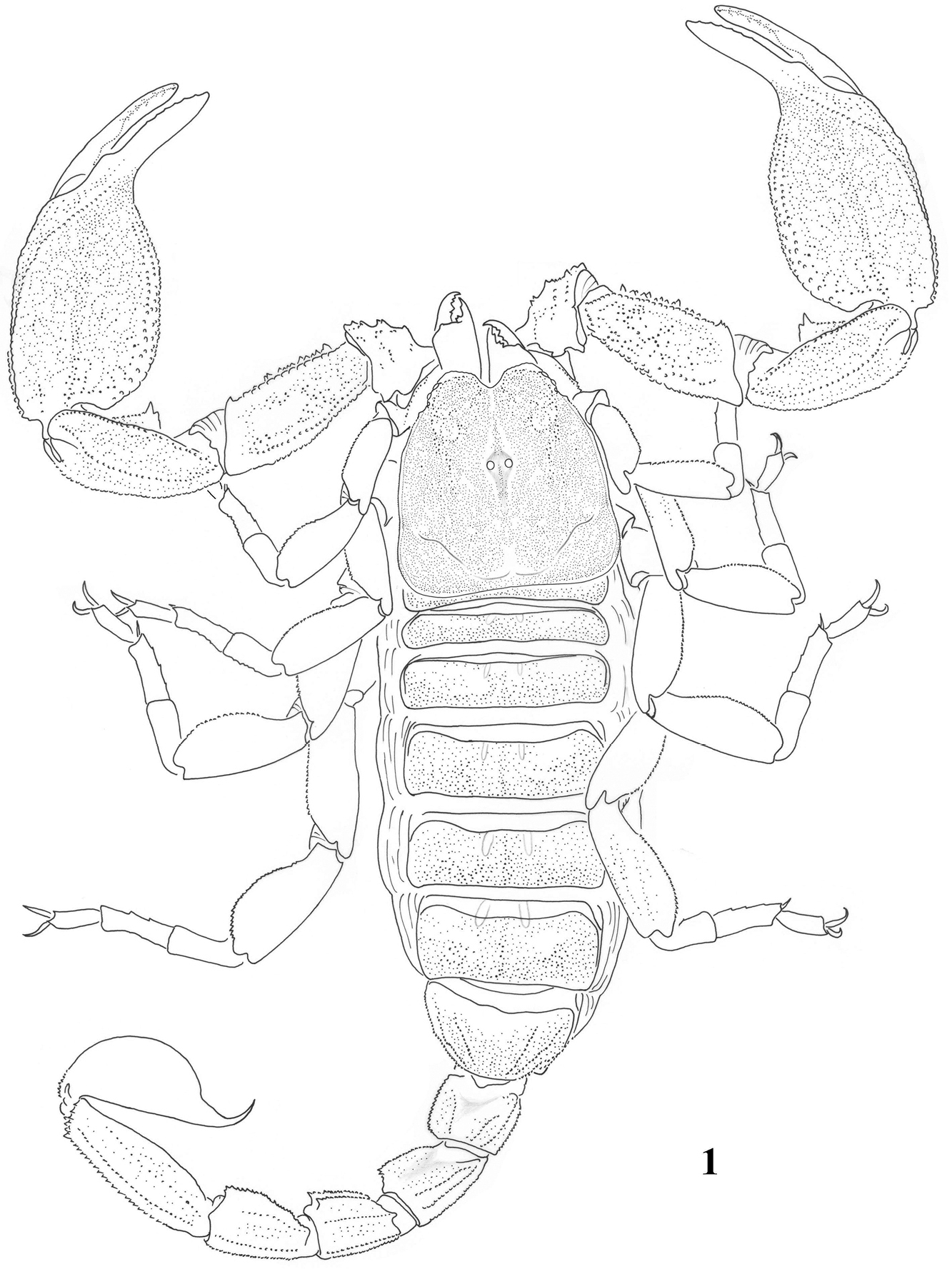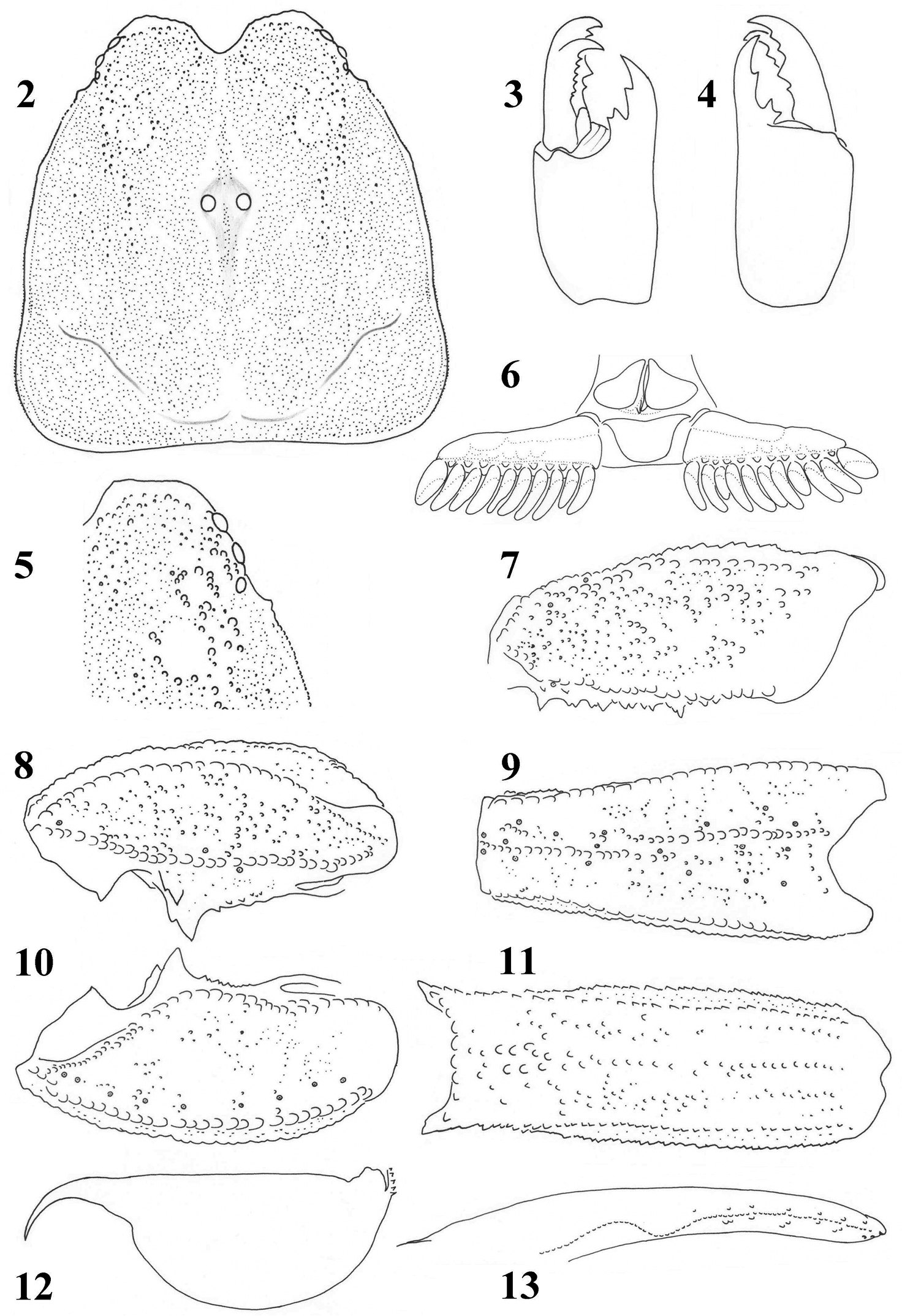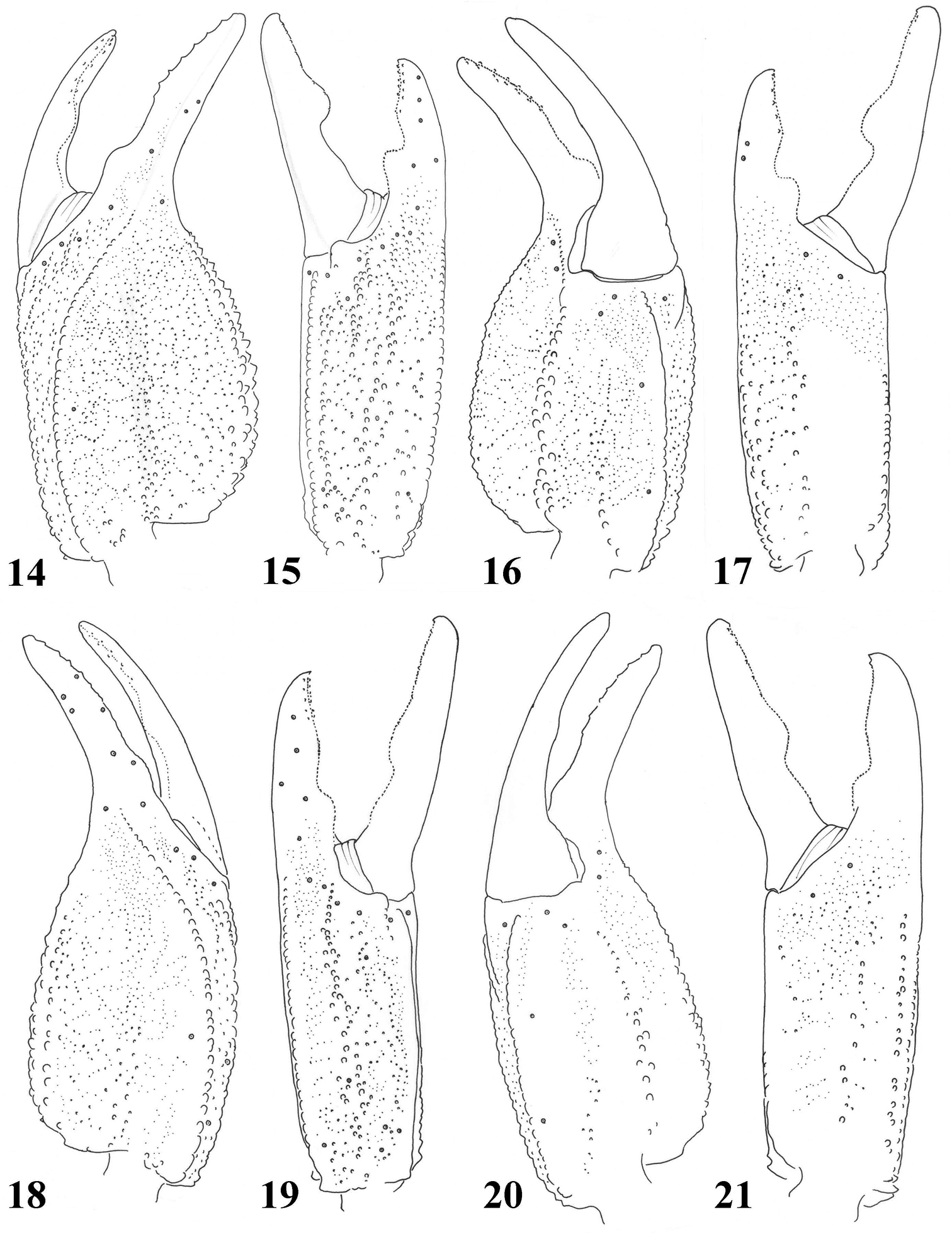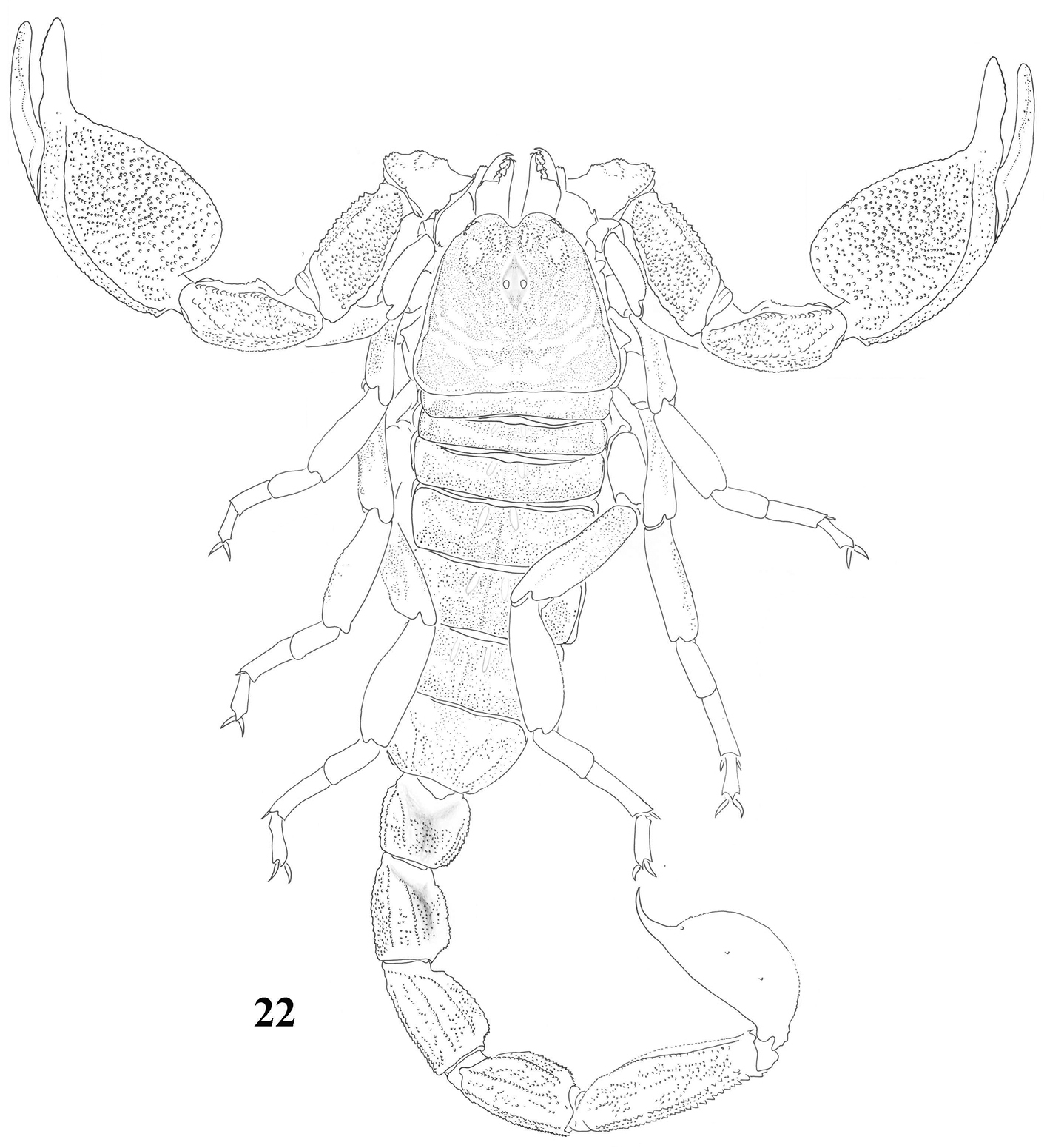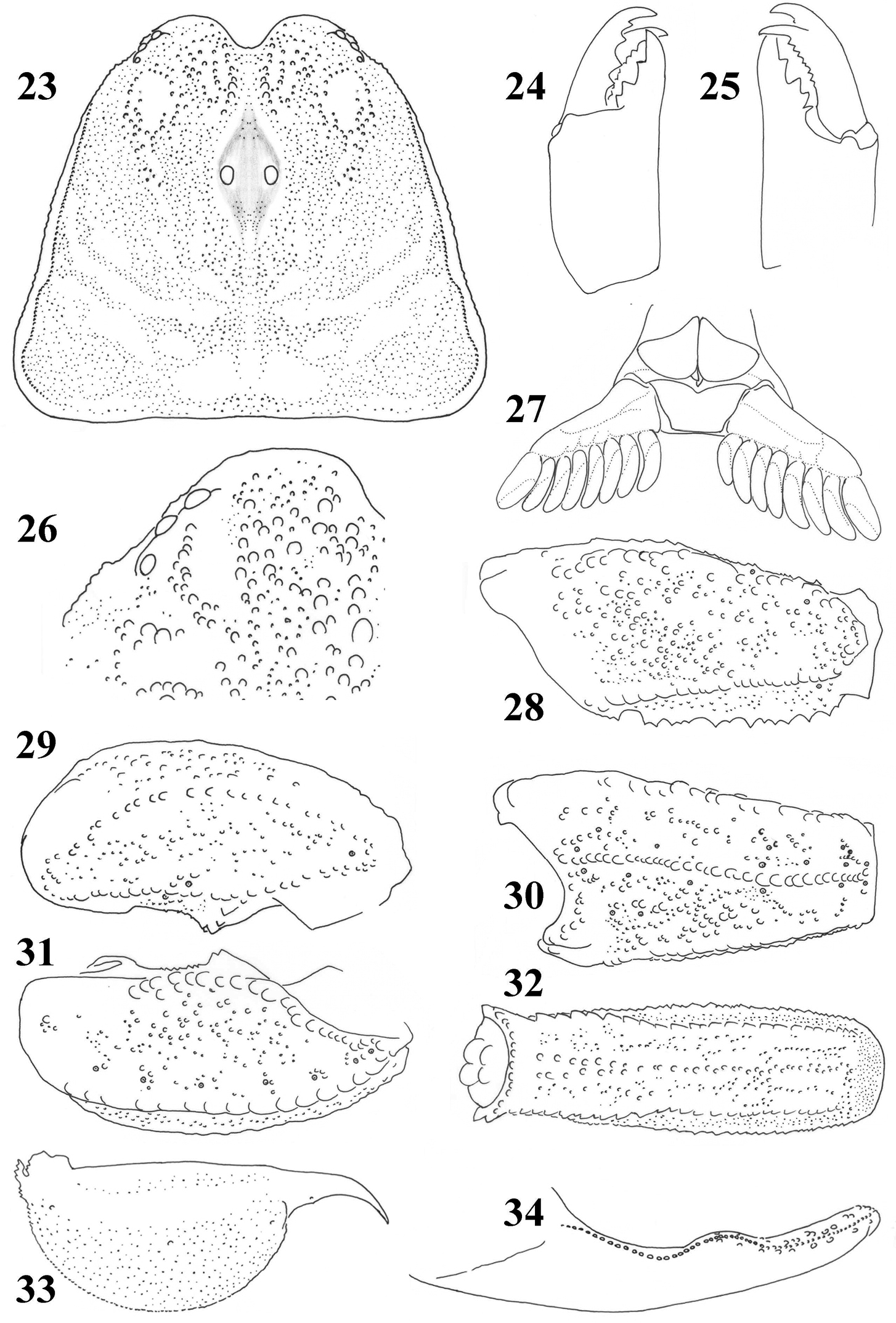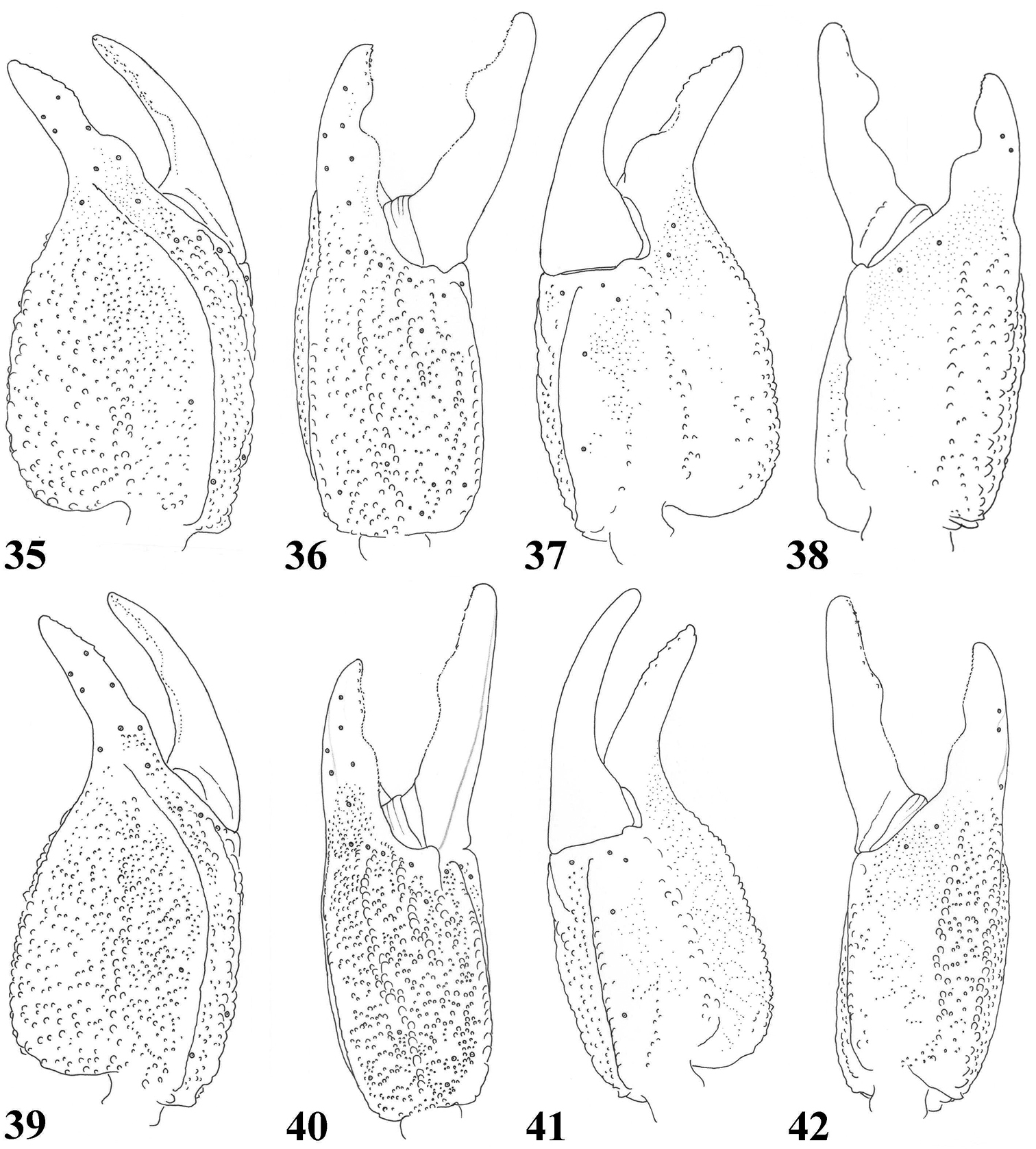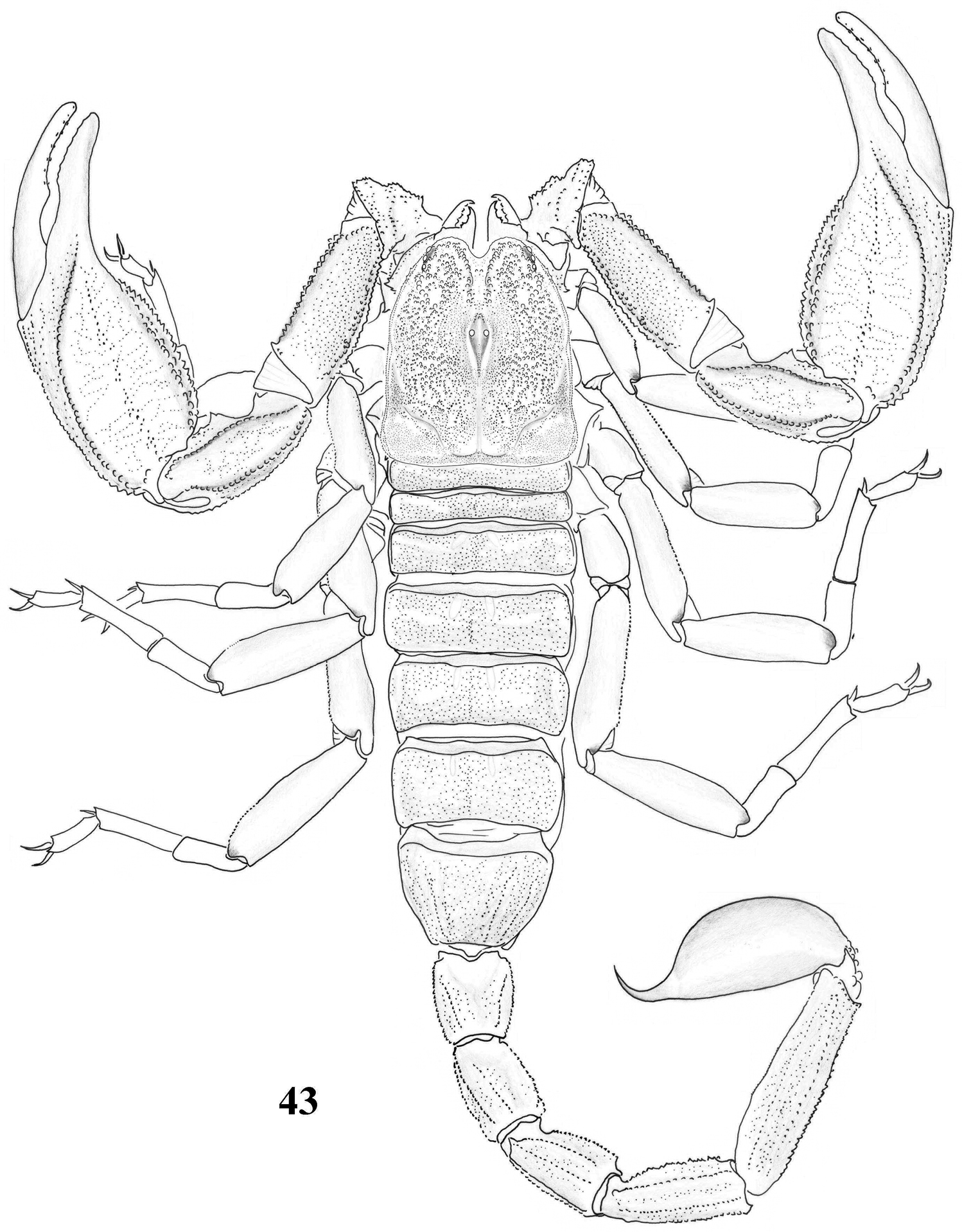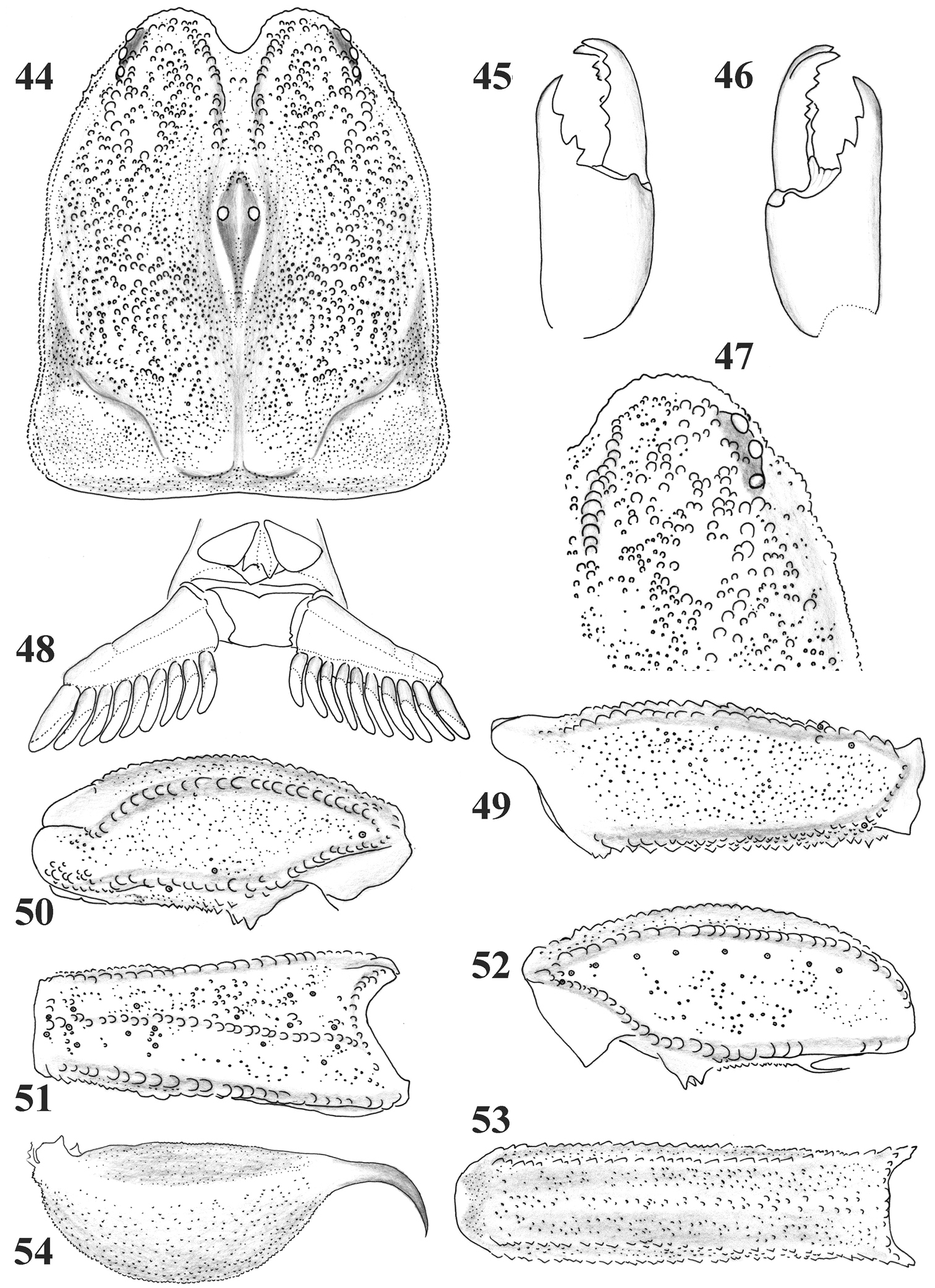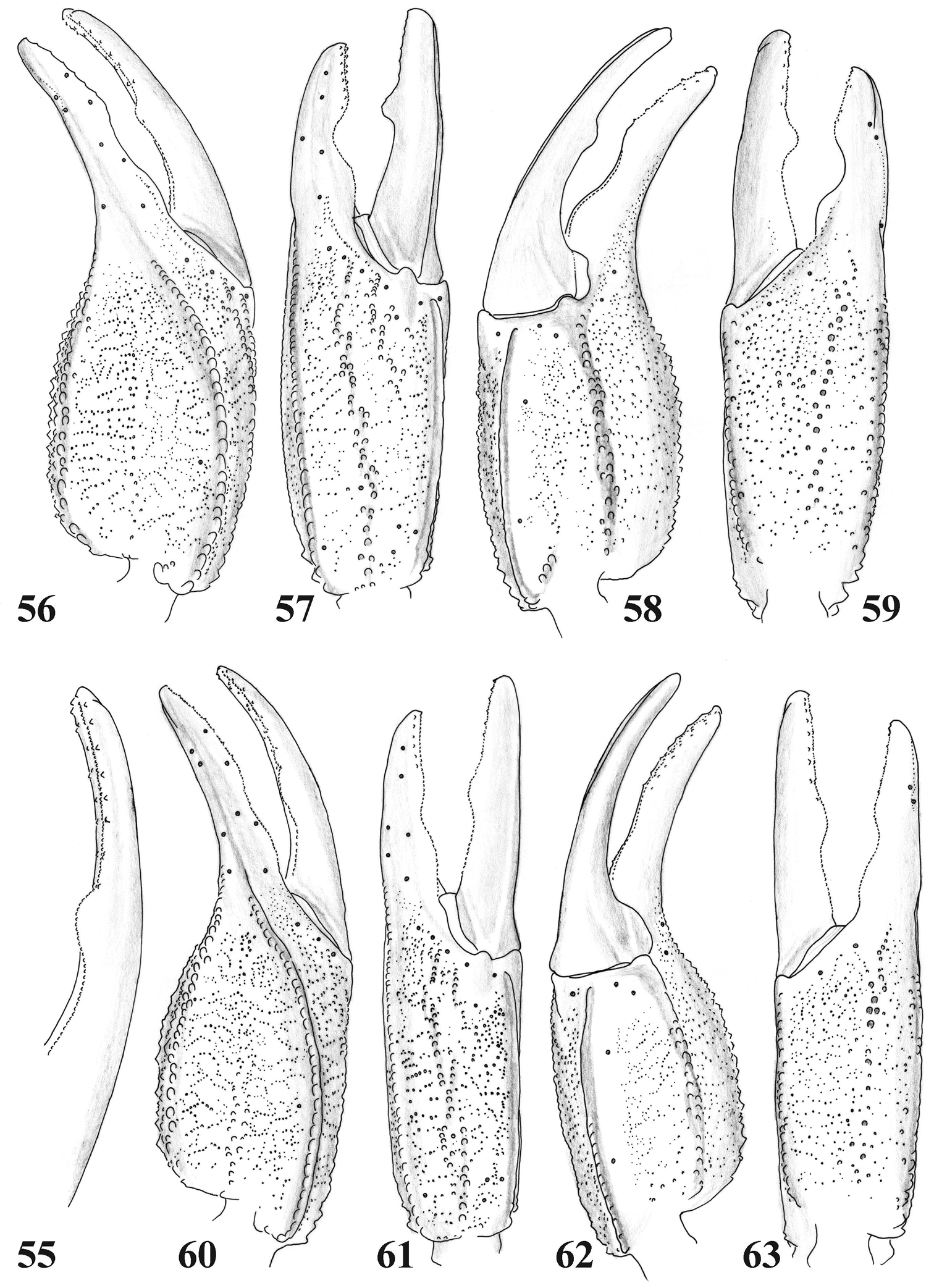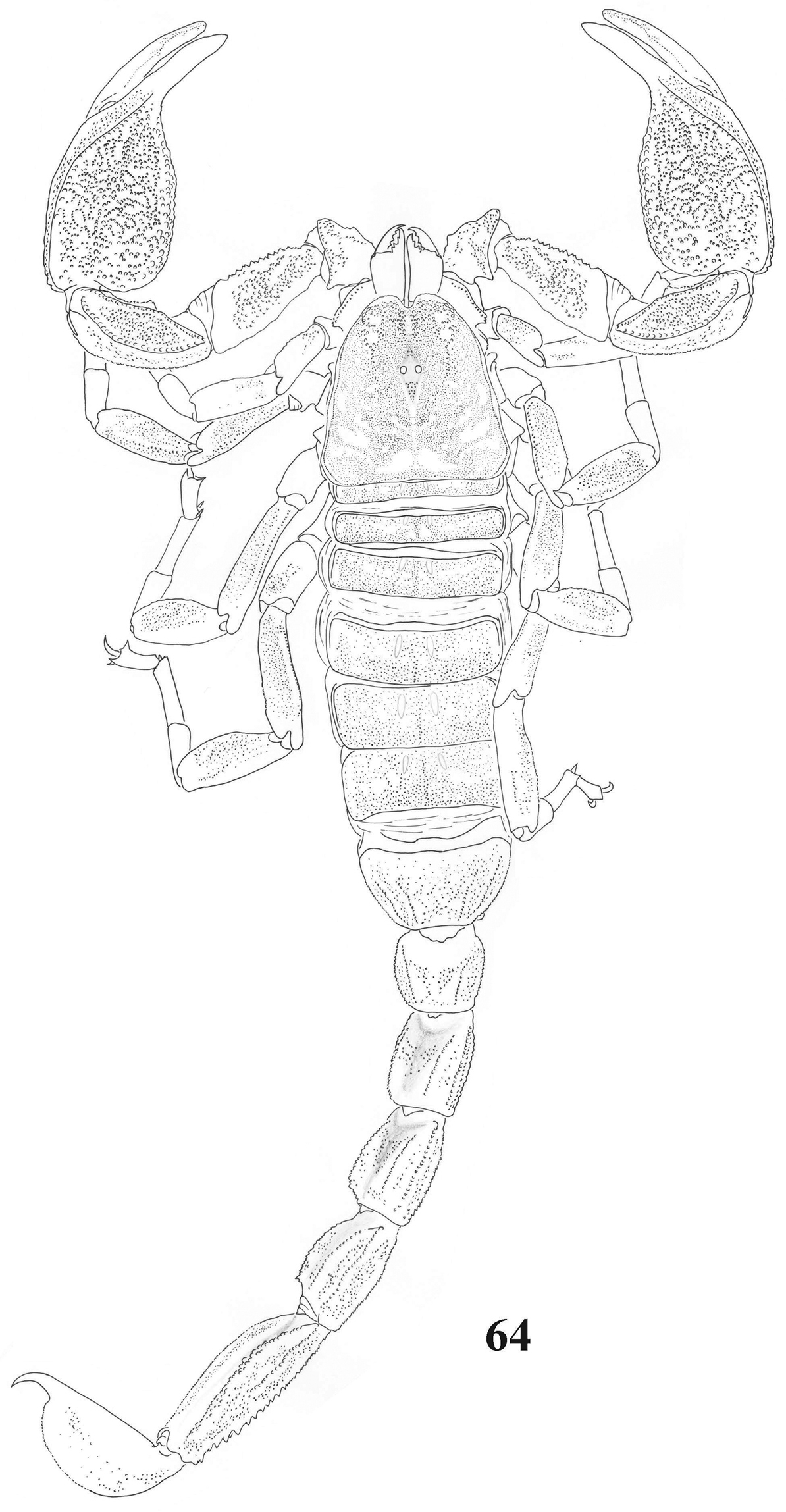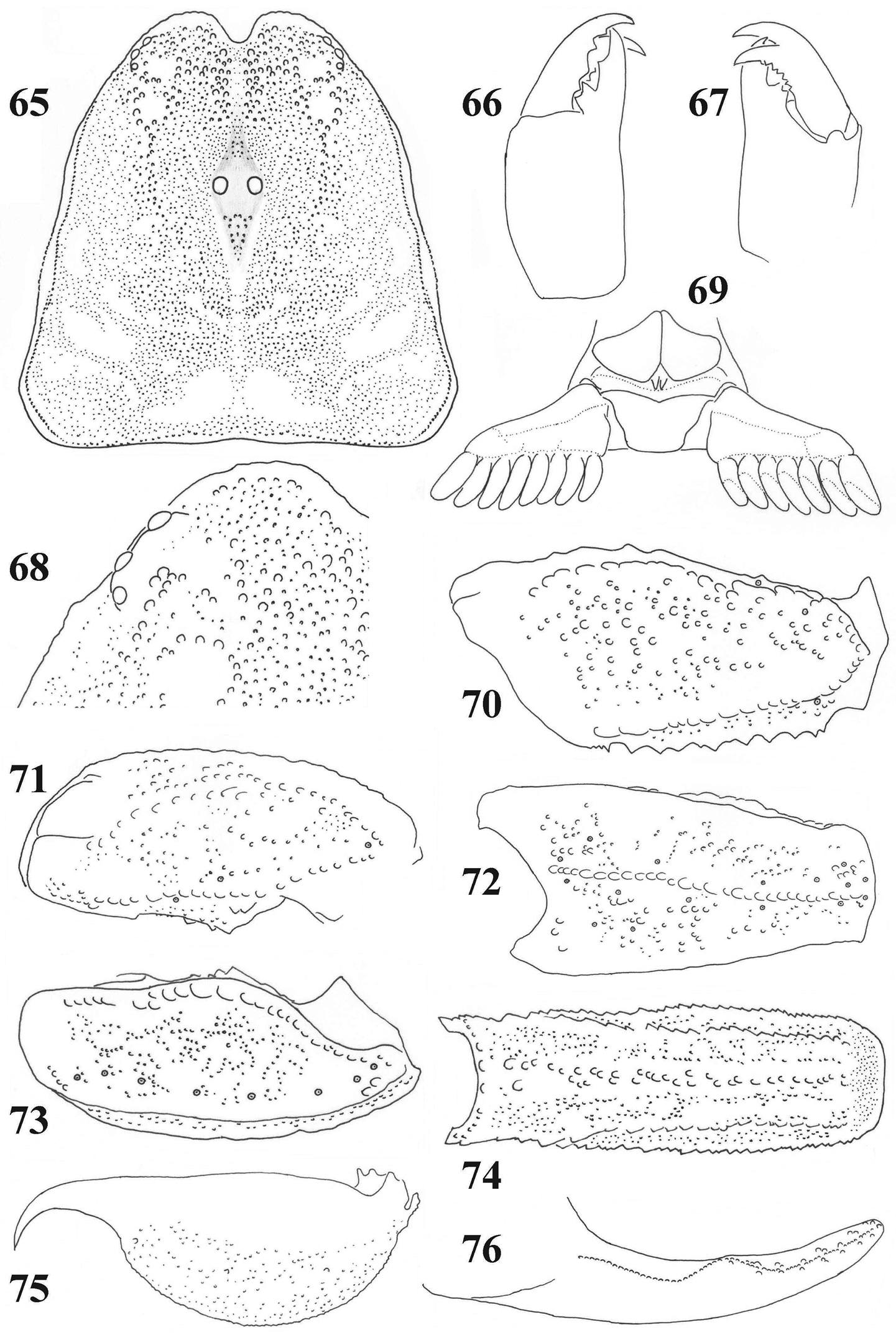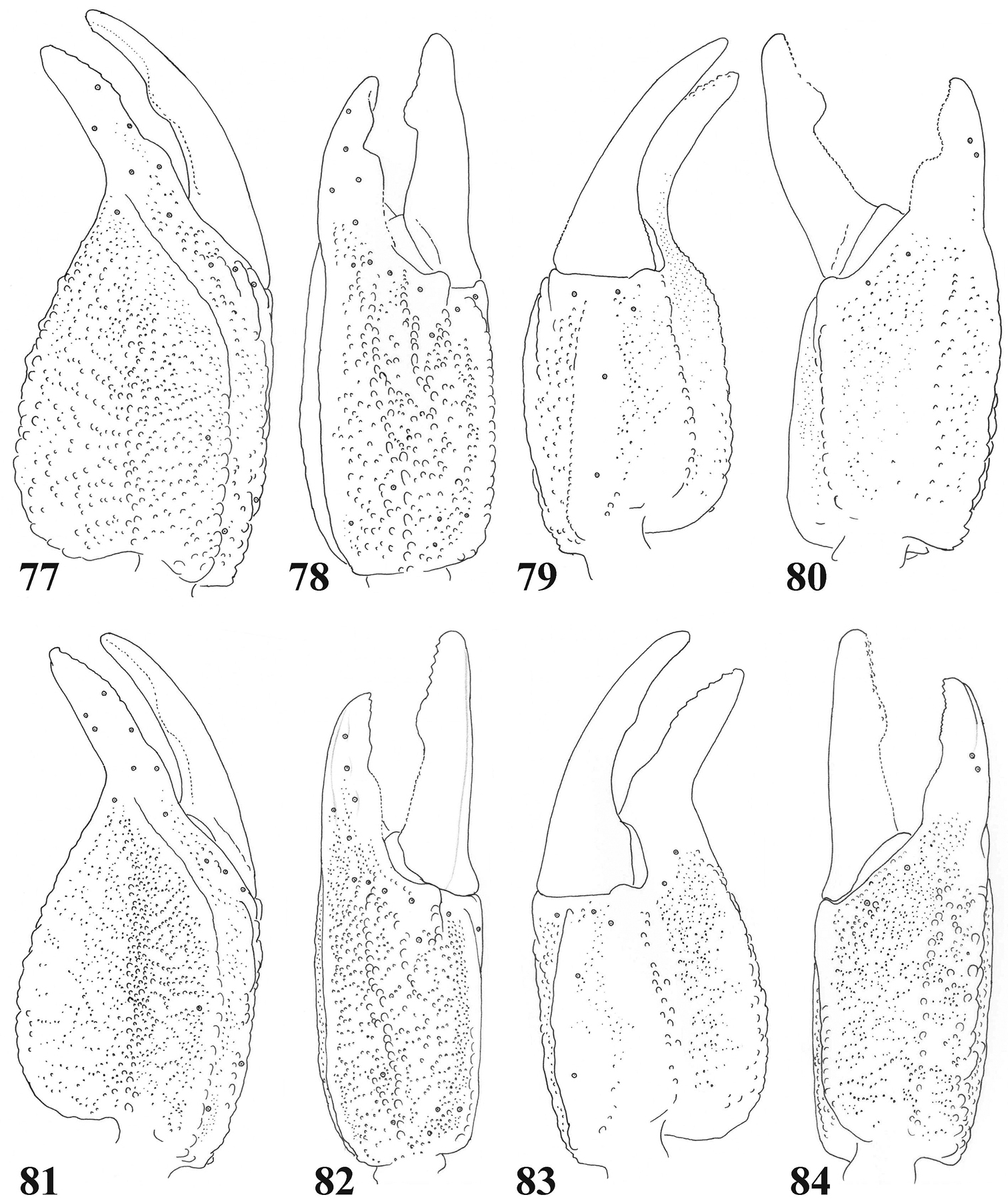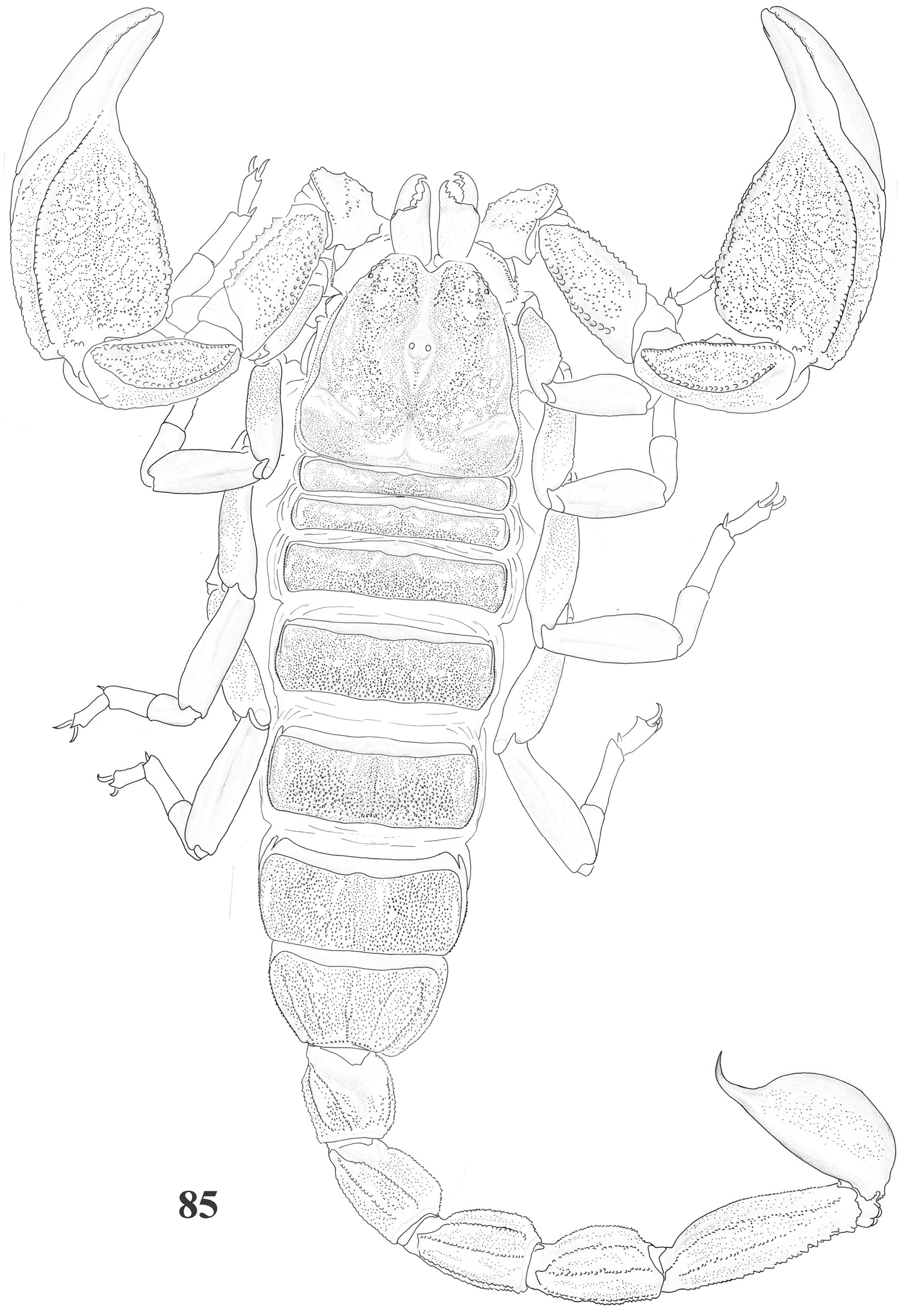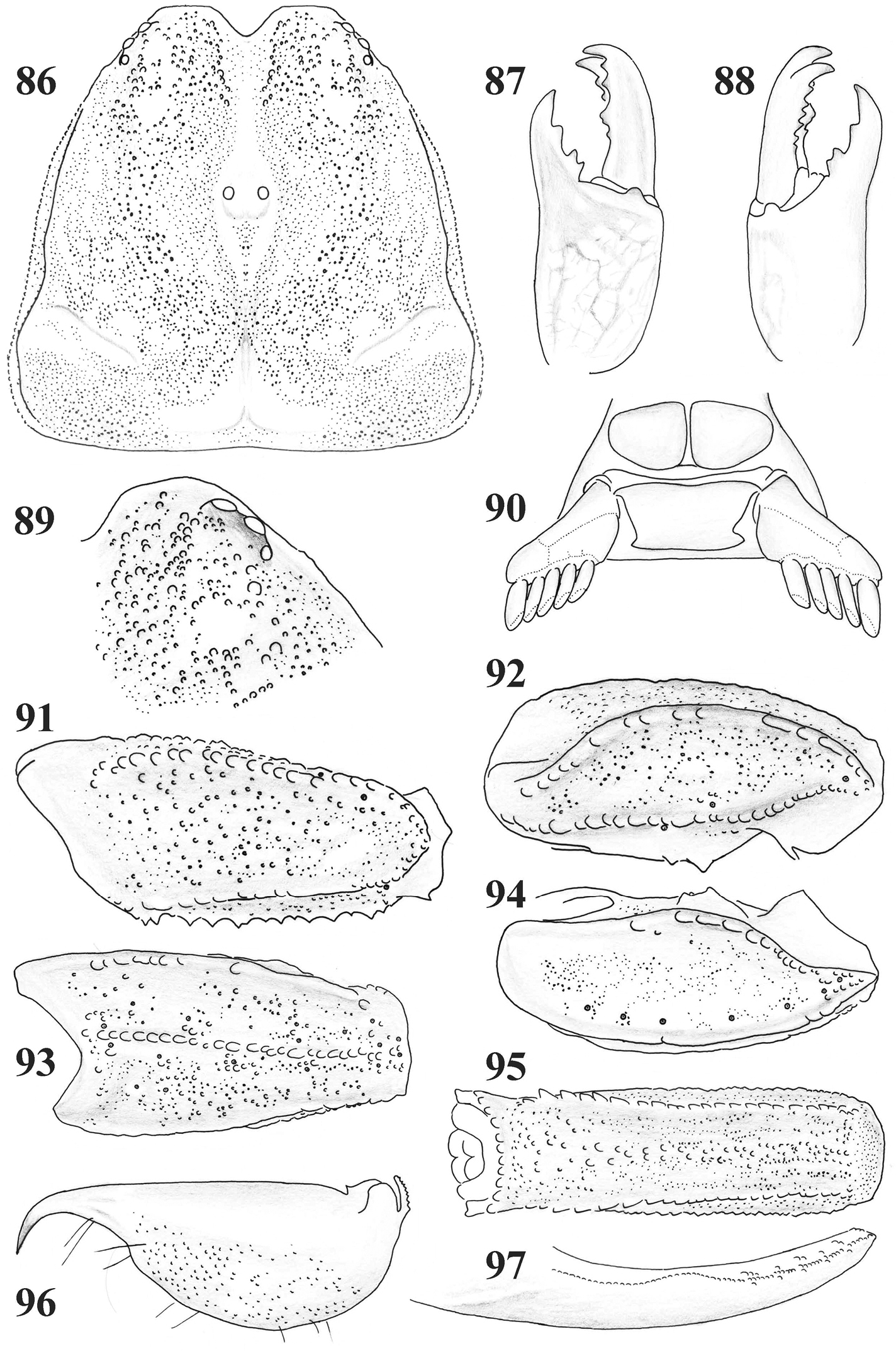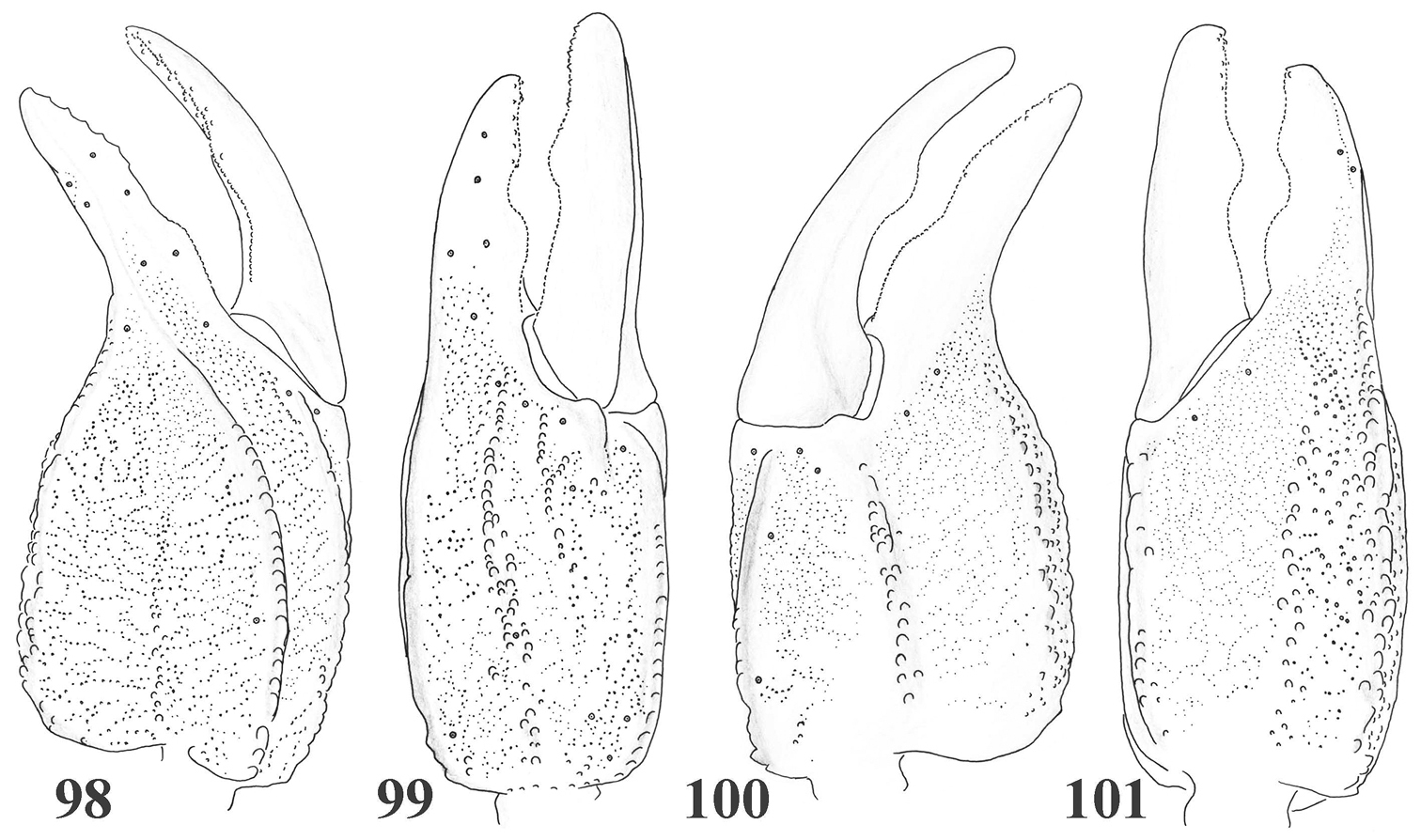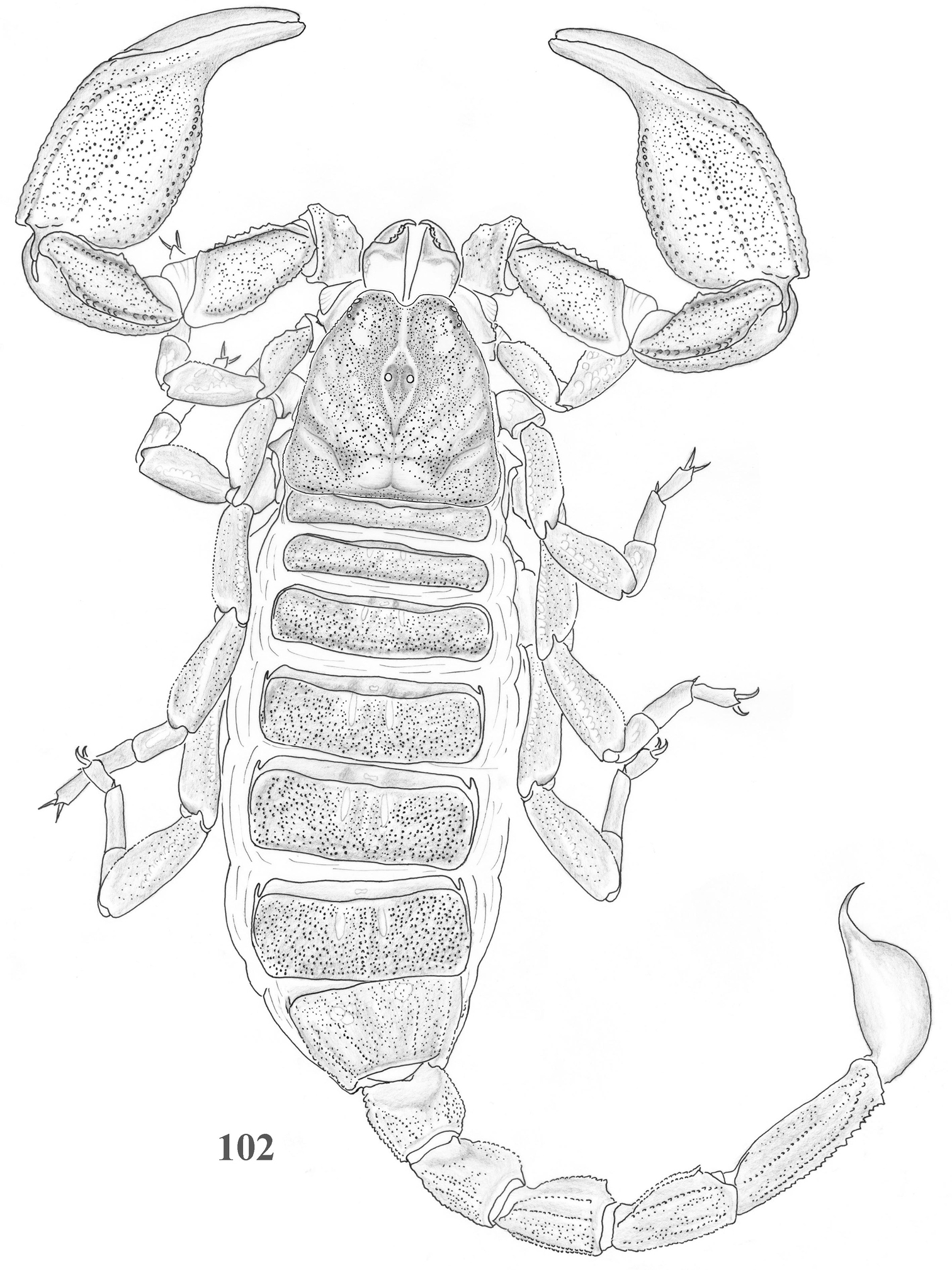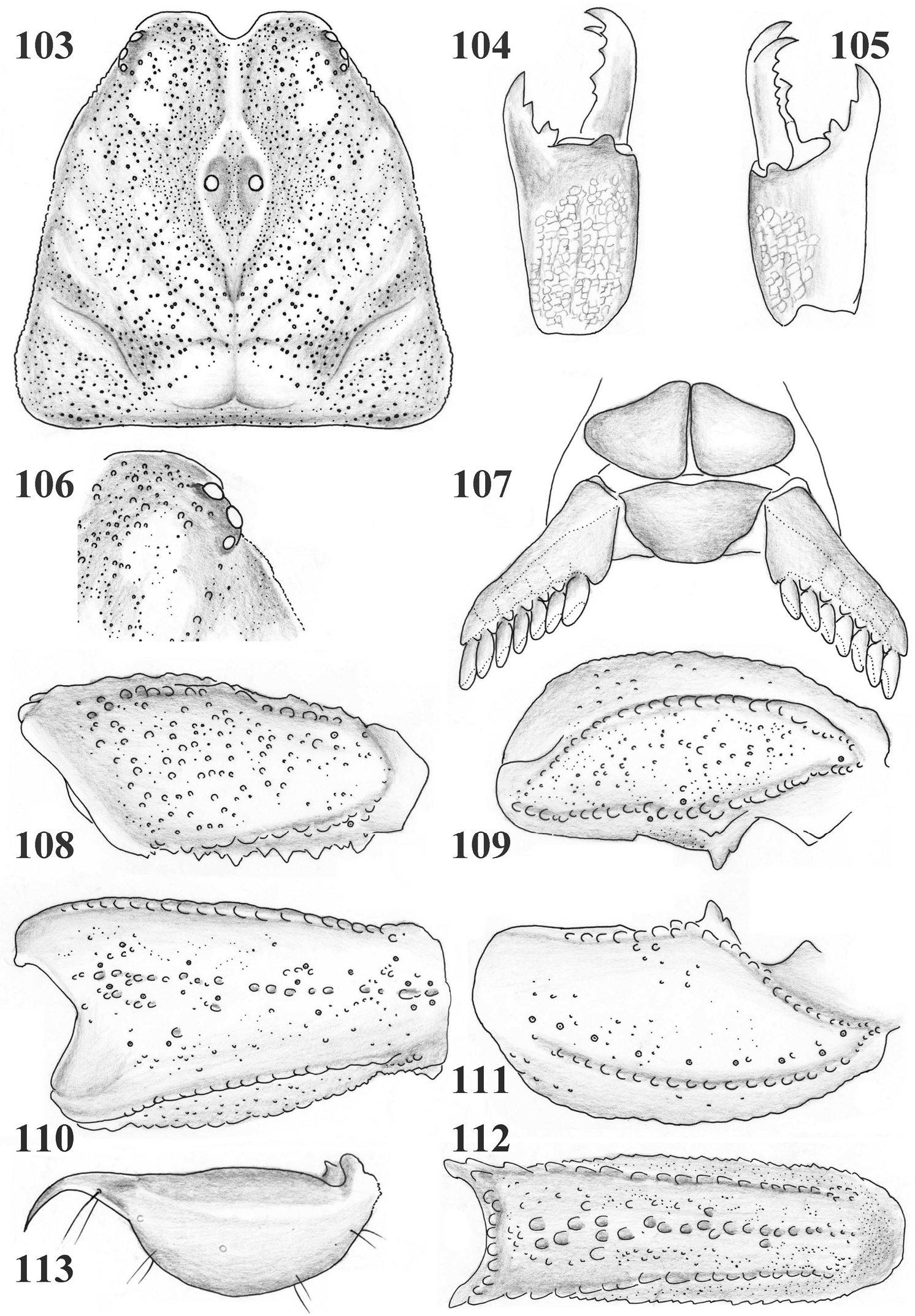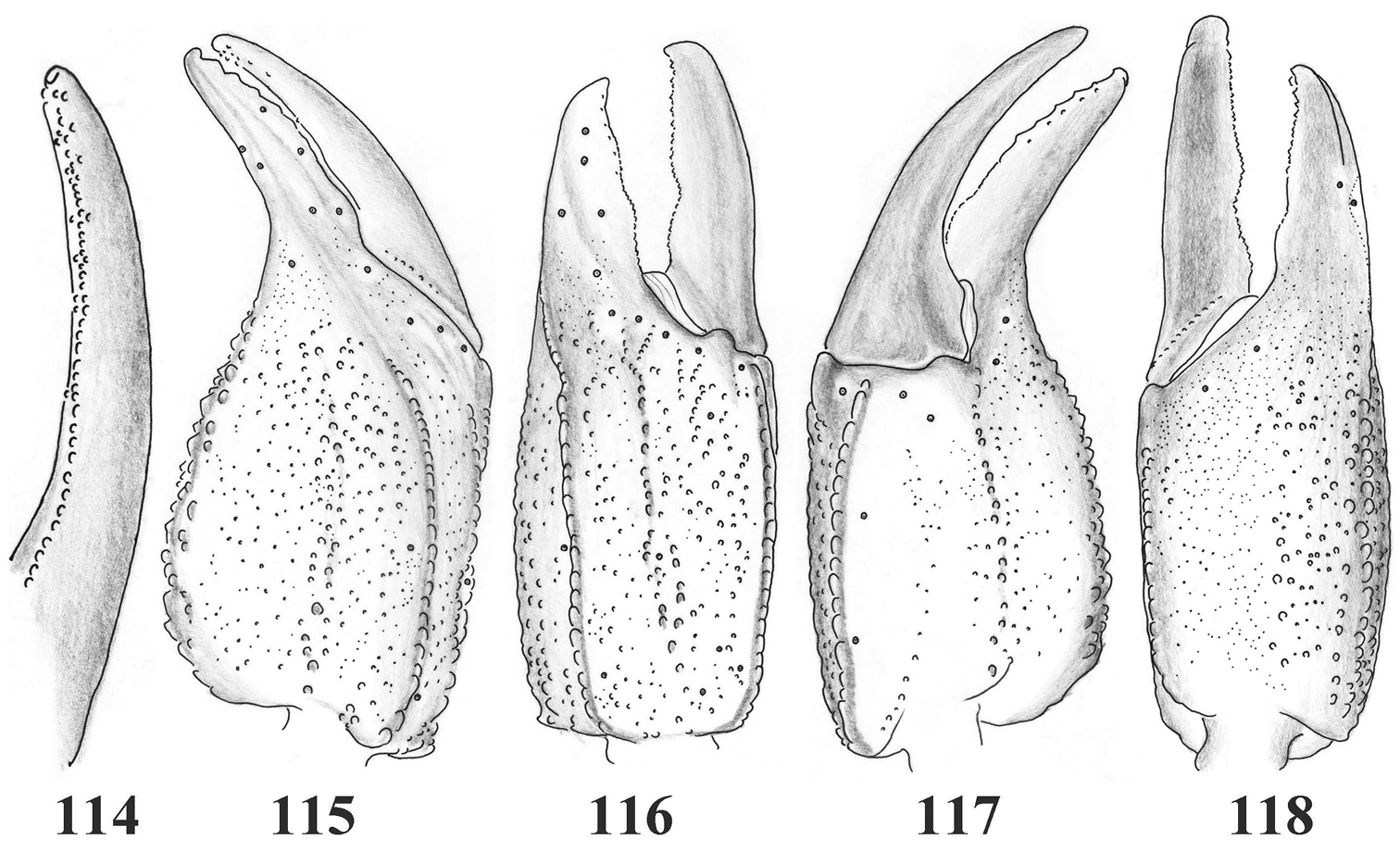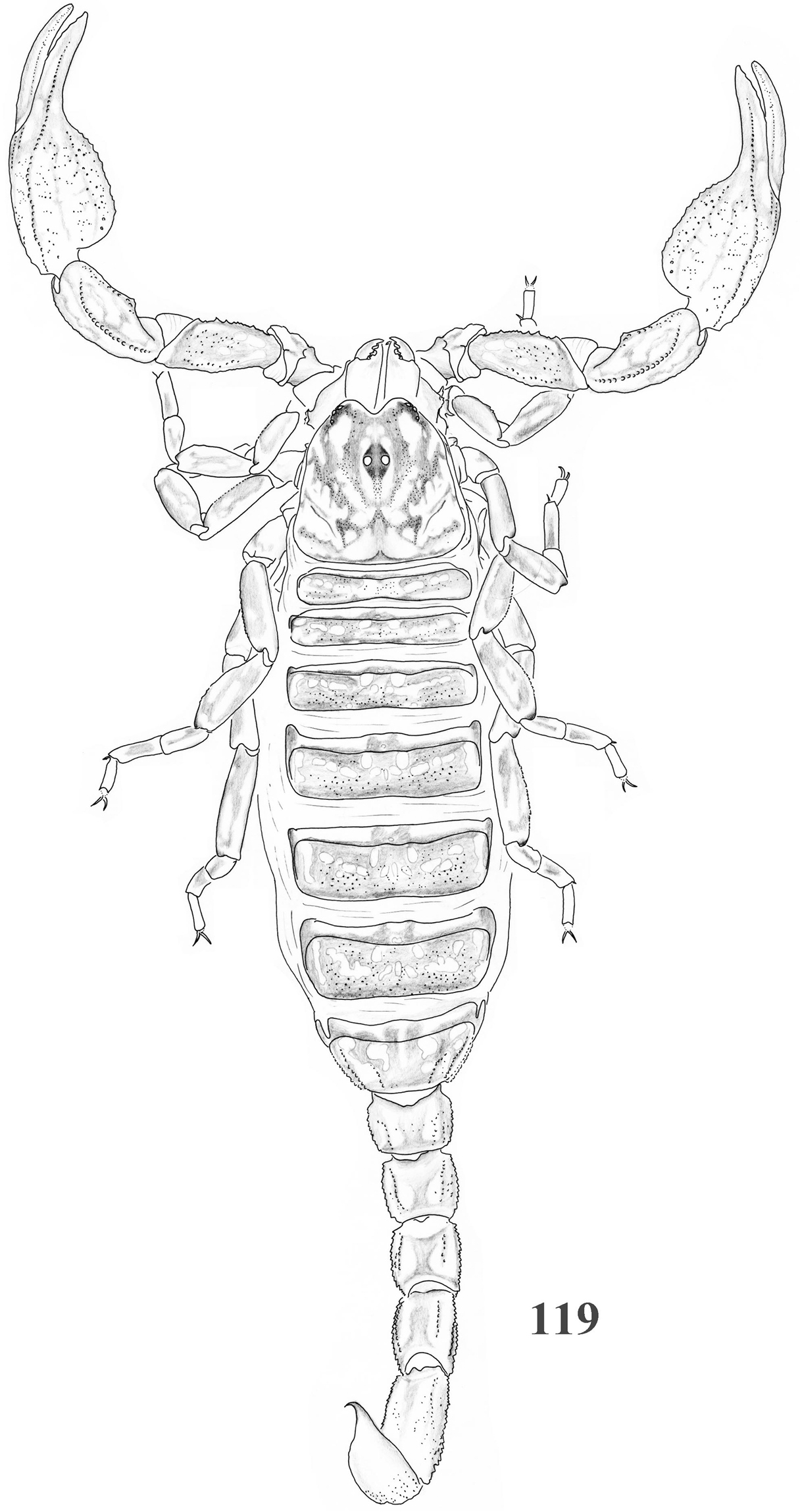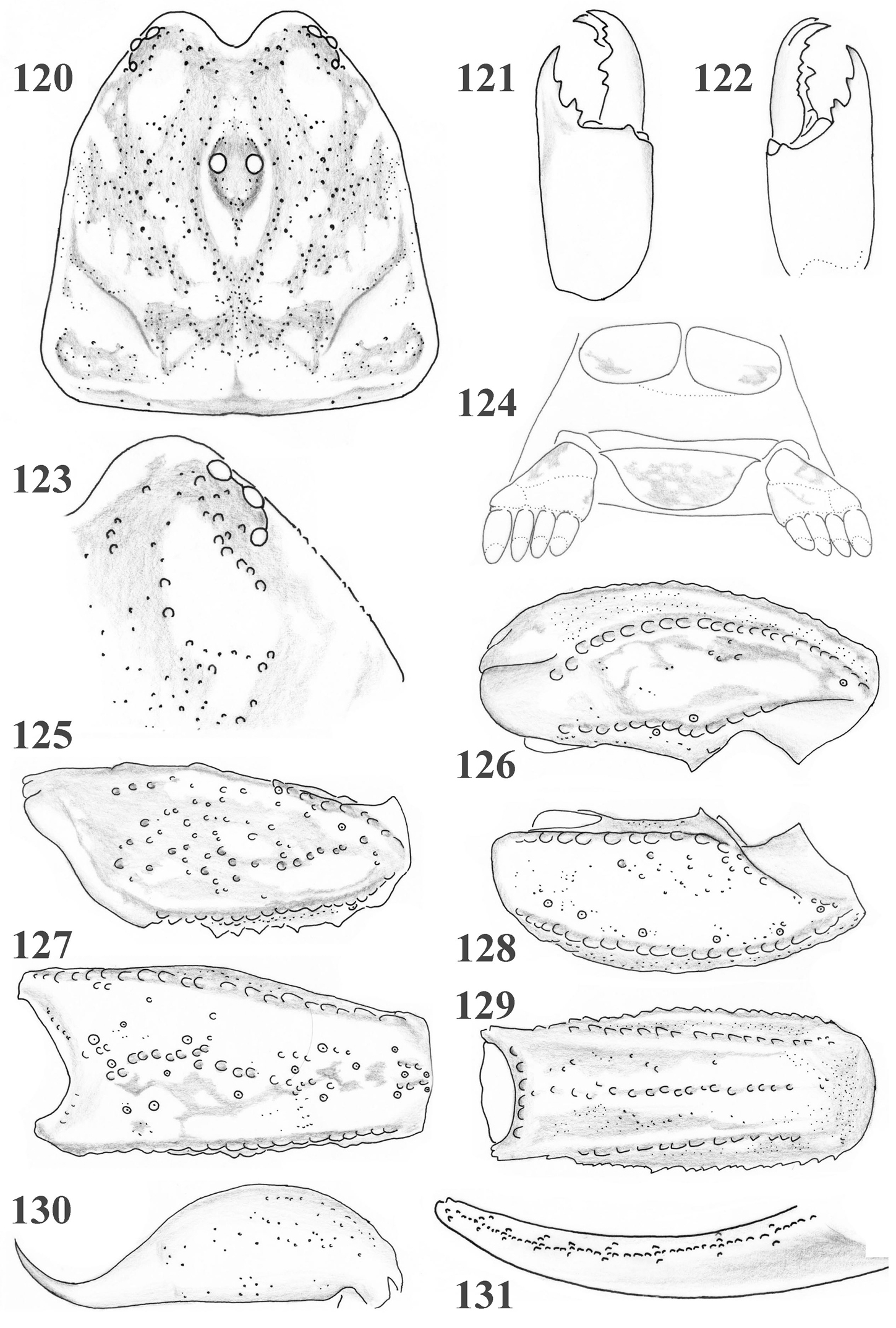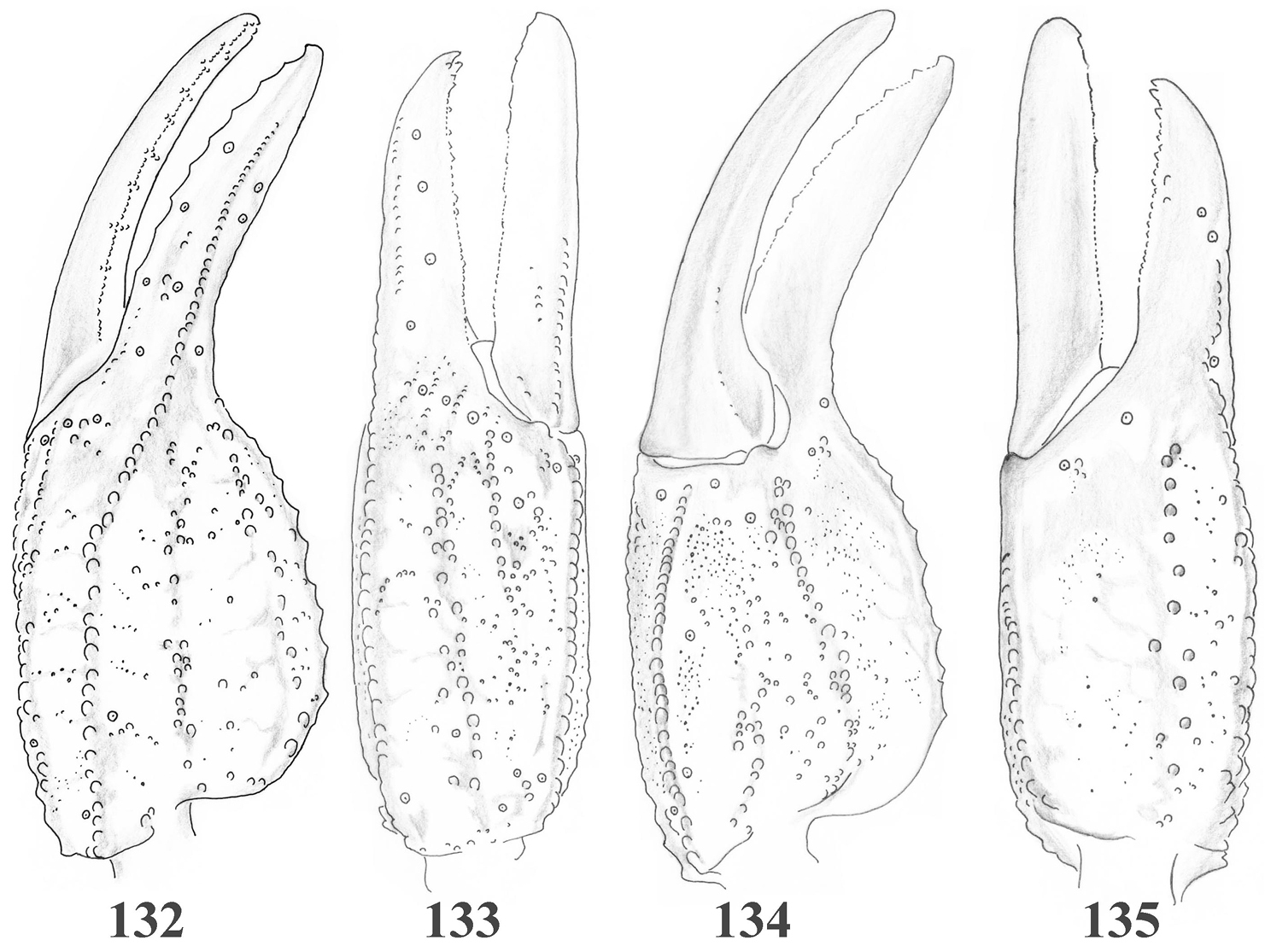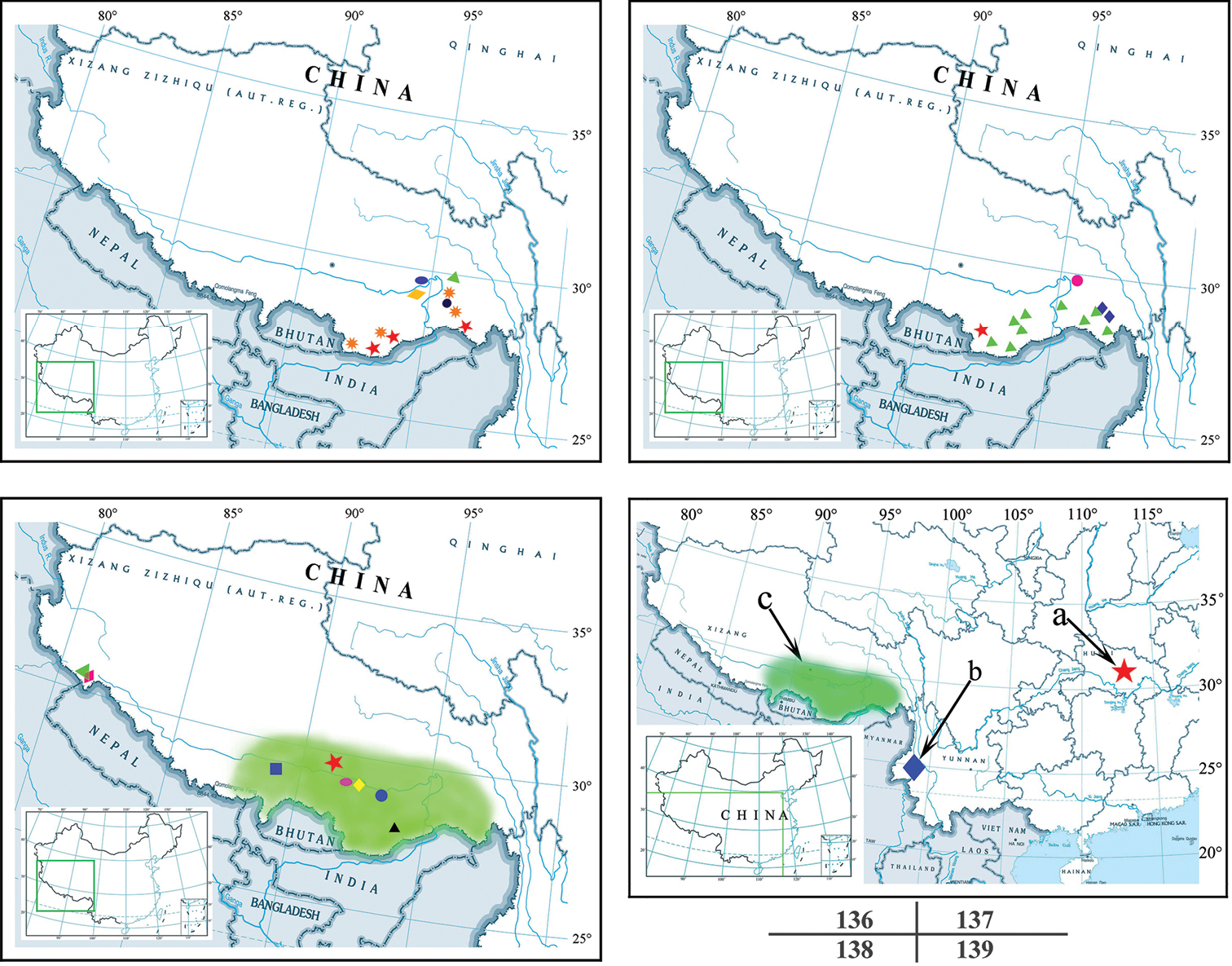






(C) 2013 Zhiyong Di. This is an open access article distributed under the terms of the Creative Commons Attribution License 3.0 (CC-BY), which permits unrestricted use, distribution, and reproduction in any medium, provided the original author and source are credited.
For reference, use of the paginated PDF or printed version of this article is recommended.
Until now, there are 26 scorpion species of 7 genera of 5 families recorded in Xizang (China). Xizang Autonomous Region (Tibet) is the scorpion biodiversity richest area in China (53 scorpion species of 12 genera of 5 families), also the highest altitude habitat of scorpions in the world. We present information of type specimens, an identification key of the scorpion species from Xizang, the distribution, updated feature pictures, and discussion on the disputed species. The redescriptions of Scorpiops jendeki Kovařík, 2000 (Yunnan) and Scorpiops tibetanus Hirst, 1911 (Xizang), comments and feature figures of species of genus Scorpiops are provided for identification.
Scorpions, Scorpiops, taxonomy, checklist, key, Tibet, Xizang
Xizang (Tibet) Autonomous Region is located in southwest China (26°52'–36°32'N, 78°24'–99°06'E), about 1, 228, 400 km2 (≈12.5% of China), famous as the “Roof of the world”. Xizang facing Xinjiang and Qinghai to the north, Sichuan and Yunnan to the east, while India, Myanmar, Bhutan, Sikkim, Nepal and Kashmir to the south and west (
Scorpiops tibetanus Hirst, 1911 (Euscorpiidae) was the first scorpion species established by Xizang (China) specimens.
Until now, twenty-six scorpion species of seven genera and five families were recorded in Xizang, all of them distribute in south and the north shores of Yarlung Zangbo Jiang. All of the eight species of Chaerilus from China found in Xizang, 10 of 11 species of Scorpiops from China living in Xizang (others: Scorpiops jendeki Kovařík, 1994 found in Yunnan, one unnamed species of Scorpiops in Hubei see
Illustrations and measurements were produced using a Motic K-700L stereomicroscope with an Abbe drawing device and an ocular micrometer. Measurements follow
Hottentotta: Fet and Lowe, 2000: 134–135; Kovařík, 2007: 2–3, 8–10. Sun et al., 2010: 40.
http://species-id.net/wiki/Hottentotta_songi
Holotype, male; Paratypes, 9 males and 9 females, China, Xizang, south region of Pulan, low valley of the river Kongque He, near to the border with Nepal, 7/1931. Male holotype, 7 male and 8 female paratypes deposited in MNHN. 2 male and 1 female paratypes deposited in MHBU.
Burang County (Pulan Xian) (China).
Isometrus: Fet & Lowe, 2000: 146; Kovařík, 2003: 1–2, figs 1–8, tab. 1.
Isometrus (Reddyanus): Fet & Lowe, 2000: 151; Kovařík, 2003: 5.
http://species-id.net/wiki/Isometrus_tibetanus
Holotype, male, China, Xizang Region of Chesu (?), 10/1970, Lindberg leg., deposited in MHBU.
Chesu (?, China).
Chaerilidae: Fet, 2000a: 323. Kovařík, 2000a: 40–41; Soleglad & Fet, 2003: 92.
Chaerilus: Fet, 2000a: 323; Kovařík, 2000a: 38; Kovařík, 2005: 1; Qi, Zhu & Lourenço, 2005: 29; Lourenço & Zhu, 2008: 462.
http://species-id.net/wiki/Chaerilus_conchiformus
Holotype, female, China, Xizang, Nyingchi County, Bayi Town, 29°41'N, 94°21'E, 17/8/2002, Ming-Sheng Zhu leg. (Ar.–MHU–XZ0201); Paratype, 1 female juvenile, China, Xizang, Nyingchi County, Bayi town, 6/8/2003, Feng Zhang leg. (Ar.–MHU–XZ0202); Paratypes, 6 females, China, Xizang, Nyingchi County, Baishuwang Town, 29°34'N, 94°30'E, 7/2006, Ming-Sheng Zhu, Xiao-Feng Yang and Long Liu leg. (Ar.–MHU–XZ0601-0606); Paratype, 1 male, China, Xizang, Mainling County, Pai Town, 29°12'N, 94°06' E, 30/7/2006, Zhu Ming-Sheng, Yang Xiao-Feng and Liu Long leg. (Ar.–MHU–XZ0102) (deposited in MHBU).
Under the stones in the farmland (highland barley) and forest (cypress).
Mainling County and Nyingchi County (China).
http://species-id.net/wiki/Chaerilus_dibangvalleycus
Holotype, male; Paratypes, 5 females, 5 males and 2 young ones, China, Xizang, Dibangvalley District, Mayodia, 1800 Mts (deposited in NCZS).
3 males and 4 females, 15/9/1991, D. B. Bastawade leg.; 1 male, 16/9/1991, K.Alia leg.; 2 males and 1 female and 2 young ones, 17/9/1991, D. B. Bastawade leg.
Mêdog County (China).
http://species-id.net/wiki/Chaerilus_mainlingensis
Holotype, female, China, Xizang, Mainling County, the Estate of Gongbuwang, 12/7/2008, Zhi-Yong Di and Guo-Dong Ren leg. (Ar.-MHU-XZML0801); 1 female paratype, same data as holotype (Ar.-MHU-XZML0802) (deposited in MHBU).
Under the stones of mixed forest.
Mainling County (China).
http://species-id.net/wiki/Chaerilus_pictus
Specific locality see Bastawade, 2006.
South Xizang (China); (Assam) India; (Silhet) Bangladesh.
http://species-id.net/wiki/Chaerilus_tessellatus
Holotype, female, China, Xizang, Mêdog County, Beibeng Town, 29°02'N, 95°03'E, 22/8/2003, Feng Zhang leg. (MHBU, Ar.–MHU–XZ0301); 2 female paratypes, China, Xizang, Bomi County, 29°08'N, 95°07'E, 14/8/2002, Ming-Sheng Zhu leg. (MHBU, Ar.–MHU–XZ0203; another deposited in MNHN); 1 female paratype, China, Xizang, Mêdog County, 108K-8K, 17/8/2003, Feng Zhang leg. (MHBU, Ar.–MHU–XZ0302).
1 female, China, Xizang, Bomi County, Mt. Sela, 3/8/2002, Ming-Sheng Zhu leg. (MHBU, Ar.–MHU–XZ0204); 2 femalejuveniles. China, Xizang, Nyingchi County, Dongjiu villige, 21/9/2007, Fu-Ming Shi leg. (MHBU, Ar.–MHU–XZ0401-02).
Bomê County (Bomi), Mêdog County and Nyingchi County (China).
http://species-id.net/wiki/Chaerilus_tricostatus
3 females, 1 female immature and 3 juveniles, China, Xizang, Mêdog County, elevation 1146m, 29°20'N, 95°20'E, 14/8/2009, Liqing Fan leg. (Ar.-MWHU-XAMT0901–07; deposited in MWHU).
Mêdog County, South Xizang (China); (Assam) India.
http://species-id.net/wiki/Chaerilus_tryznai
Holotype, male; Allotype and Paratype (No. 1), 2 females; Paratypes Nos. 2–12, 10 females and 1 immature, China, Xizang, Bomi County, 29°52'N, 95°45'E, 3000m, M. Tryzna & O. Safranek, FKCP.
China, Xizang, Mêdog County, 29°02’N, 95°03’E, Hanmi Village, 11/8/2006, 1 female, Zhi-Shun Song leg. (Ar.–MHU–XZ0607) (in MHBU); China, Xizang, Mêdog County, Hanmi Village, 10/8/2006, 1 female, Zhi-Shun Song leg. Zhi-Shun Song leg. (Ar.–MHU–XZ0608) (deposited in MHBU).
Under the stones in the mixed forest.
Bomê County, Mêdog County (China).
Five related species with close geographical distribution, Chaerilus assamensis: Kraepelin, 1913, Chaerilus conchiformus, Chaerilus dibangvalleycus, Chaerilus mainlingensis, and Chaerilus tryznai, all with 7–8 granulated cutting edges on the movable fingers of pedipalp (
http://species-id.net/wiki/Chaerilus_wrzecionkoi
Holotype, allotype and paratypes, 2 males and 2 females, China, Xizang, Tomi (Tangmai), 30 km W of Donjung, 2075 m a.s.l., 23/6/2007, leg. A. Wrzecionko; FKCP.
Tangmai (Tongmai?), Tomi (Bomê County?) (China).
Chaerilus wrzecionkoi are closest with Chaerilus mainlingensis Di & Zhu, 2009 and Chaerilus tryznai Kovařík, 2000. Both have manus and patella of pedipalp narrower and longer than other congeneric species. Chaerilus mainlingensis has four distinct carinae on the seventh sternite; Chaerilus wrzecionkoi has the seventh sternite granulated but without carinae; manus of pedipalp in male narrow and long, chela length/width ratio in male higher than 3 in Chaerilus tryznai Kovařík, 2000, while manus of pedipalp in male robust and chela length/width ratio in adults lower than 2.6 in Chaerilus wrzecionkoi (see Kovařík, 2012).
Euscorpiidae: Fet & Sissom, 2000: 355; Soleglad & Fet, 2003: 105.
Scorpiopidae: Fet, 2000d: 487; Kovařík, 2000b: 154.
Euscorpiops: Fet & Sissom, 2000: 488. Kovařík, 2000b: 154; Kovařík, 2005: 1, 4; Kovařík, 2012a: 1, 3.
http://species-id.net/wiki/Euscorpiops_asthenurus
Specific locality see Bastawade, 2006.
South Xizang (China); Bhutan; (Assam, West Bengal, Sikkim) India.
http://species-id.net/wiki/Euscorpiops_kamengensis
Holotype, male; Paratype, 1 female immature, China, South Xizang, West Kameng, 7 Kms of Bomdilla, Sara village, 2500 mts. D. B. Bastawade leg. 18/9/1991 (deposited in NCZS).
South Xizang (China).
http://species-id.net/wiki/Euscorpiops_karschi
Holotype, female, China, Xizang, Zayü district, Xia Zayü town (28°30'N, 97°00'E), 8/8/2002, Ming-Sheng Zhu leg. (MHBU, Ar.-MHBU-XZZY0201). Paratypes: 2 females and 2 immature males, same data as holotype (one female in MHBU, Ar.-MHBU-XZZY0202); one female in MNHN, Ar.-MNBU-XZZY0203).
1 male, China, Xizang, Zayü district, Xia Zayü town (28°30’N, 97°00’E), 2/10/2007, Fu-Ming Shi leg. (MHBU, Ar.-MHBU-XZZY0701); 1female, China, Xizang, Zayü district, Shang Zayü town, 23/8/2005, Zhi-Shun Song leg. (MHBU, Ar.-MHBU-XZZY0501).
Zayü County (Zayü district, Chayu district) (China).
http://species-id.net/wiki/Euscorpiops_novaki
Holotype, male, China, Xizang, Bomi County (29°52' N, 95°45'E), ca 3000 m, 1988, P. Rojek leg., FKCP.
Bomê County (China).
Scorpiops: Fet, 2000d: 491; Kovařík, 2000b: 162, 164, 166; Qi, Zhu & Lourenço, 2005: 2; Di & Zhu, 2009: 40; Di et al., 2011b, 1–2. Kovařík, 2009: 1.
http://species-id.net/wiki/Scorpiops_atomatus
Figures 1–21, Table 1Holotype, male, China, Xizang, Lang district (29.02°N, 93.08°E), 7-8/2004, Ai-Min Shi and Yi-Bin Ba leg. (MHBU). Paratypes: 3 females, 1 male, same data as holotype (2 females in MHBU, 1 female and 1 male in MNHN); 1male, China, Xizang, Chayu district, Xia Zayü town (28.4°N, 97.0°E), 7/8/2002, Ming-Sheng Zhu leg. (MHBU?); 2 females, China, Xizang, Lang district (29.02°N, 93.08°E), 20 August 2002, Ming-Sheng Zhu leg. (MHBU?); 1 male, China, Xizang, Gyaca district (29.1°N, 92.7°E), 21/8/2002, Ming-Sheng Zhu leg. (MHBU?); 1 male, 1female, 22 August 2002, other data same as above (MHBU?).
Gyaca County, Nang County (Lang district, Langxian district), Zayü County (China).
Measurements (in mm) of Scorpiops atomatus, Scorpiops langxian and Scorpiops luridus.
| Species Contents |
Scorpiops atomatus | Scorpiops langxian | Scorpiops luridus | |||
|---|---|---|---|---|---|---|
| Sex | Male HT (MHBU) |
Female PT (MHBU) |
Male HT (MHBU) |
Female PT (MHBU) |
Male HT (MHBU) |
Female PT (MHBU) |
| Total length | 42.1 | 40.4 | 63.0 | 58.5 | 86.7 | 75.1 |
| Carapace: | ||||||
| -Length | 6.2 | 6.4 | 7.7 | 7.3 | 11.7 | 10.2 |
| - Anterior width | 3.7 | 4.0 | 4.3 | 4.0 | 5.0 | 4.1 |
| - Posterior width | 6.5 | 6.2 | 8.4 | 7.9 | 10.6 | 9.2 |
| Metasomal segment I: | ||||||
| - Length | 2.4 | 2.3 | 4.1 | 3.9 | 4.3 | 4.1 |
| - Width | 2.4 | 2.4 | 3.8 | 3.5 | 4.5 | 4.1 |
| - Depth | 2.0 | 1.9 | 3.1 | 2.8 | 3.7 | 3.2 |
| Metasomal segment II: | ||||||
| - Length | 2.9 | 2.6 | 4.7 | 4.3 | 4.9 | 4.2 |
| - Width | 2.1 | 2.1 | 3.6 | 3.2 | 4.0 | 3.7 |
| - Depth | 1.8 | 1.9 | 2.9 | 2.8 | 3.7 | 3.1 |
| Metasomal segment III: | ||||||
| - Length | 3.1 | 2.9 | 5.2 | 4.9 | 5.7 | 5.1 |
| - Width | 2.0 | 2.0 | 3.3 | 3.1 | 3.8 | 3.2 |
| - Depth | 1.8 | 2.0 | 3.0 | 2.6 | 3.6 | 3.1 |
| Metasomal segment IV | ||||||
| - Length | 3.6 | 3.1 | 5.7 | 5.5 | 7.8 | 6.4 |
| - Width | 1.8 | 1.9 | 3.2 | 2.9 | 3.6 | 3.1 |
| - Depth | 2.0 | 2.0 | 3.0 | 2.6 | 3.7 | 3.1 |
| Metasomal segment V | ||||||
| - Length | 5.4 | 5.2 | 9.0 | 8.3 | 12.8 | 9.6 |
| - Width | 1.8 | 2.0 | 2.9 | 2.6 | 3.2 | 2.7 |
| - Depth | 1.8 | 1.9 | 2.9 | 2.4 | 3.3 | 2.8 |
| Telson: | ||||||
| - Length | 5.9 | 5.5 | 8.8 | 7.4 | 12.8 | 10.2 |
| - Width | 2.0 | 1.9 | 3.7 | 3.0 | 4.6 | 4.0 |
| - Depth | 2.0 | 1.8 | 3.4 | 2.7 | 4.6 | 3.8 |
| Pedipalp femur: | ||||||
| - Length | 5.6 | 5.6 | 6.1 | 6.1 | 10.2 | 8.9 |
| - Width | 2.6 | 2.4 | 2.6 | 2.7 | 3.8 | 3.7 |
| - Depth | 1.9 | 1.9 | 2.4 | 2.4 | 2.6 | 2.6 |
| Pedipalp patella: | ||||||
| - Length | 5.1 | 5.3 | 6.0 | 5.3 | 9.6 | 8.3 |
| - Width | 2.8 | 2.7 | 3.1 | 3.1 | 4.5 | 4.1 |
| - Depth | 2.3 | 2.3 | 3.1 | 3.2 | 3.8 | 3.8 |
| Chela | ||||||
| - Length (chela) | 10.0 | 9.9 | 11.2 | 11.5 | 23.5 | 20.0 |
| - Length (manus) | 6.1 | 6.2 | 6.6 | 6.7 | 12.0 | 10.2 |
| - Width | 4.4 | 4.2 | 6.2 | 5.8 | 7.3 | 6.4 |
| - Depth | 3.0 | 2.8 | 4.6 | 4.2 | 5.7 | 4.6 |
| Movable finger-Length | 5.9 | 5.9 | 7.4 | 7.3 | 11.5 | 9.8 |
| Pectinal teeth (left/right) | 10/11 | 9/9 | 8/8 | 6/6 | 10/10 | 8/8 |
Habitus of Scorpiops atomatus, male, holotype, dorsal view.
Scorpiops atomatus, male, holotype. 2 Carapace 3–4 Chelicera, dorsal and ventral aspects 5 Lateral eyes 6 Genital operculum and pectines 7 Femur dorsal aspect 8–10 Patella dorsal, external and ventral aspects 11 Metasomal segment V, ventral aspect 12 Telson, lateral aspect 13 Dentate margin of movable finger, showing rows of granules.
Scorpiops atomatus, male, holotype. Chela (left) dorsal, external, ventral and internal aspects 18–21 Scorpiops atomatus, female, paratype. Chela dorsal, external, ventral and internal aspects.
http://species-id.net/wiki/Scorpiops_hardwickii
1 male, 3 females and 3 juveniles, China, Xizang, Nyainqentangha Mts, Lhasa, 3800m, V. Major leg. FKCP.
Lhasa, Xizang (China); (Himachal, Uttar, Jammu, Kashmir, Punjab) India; Nepal; Pakistan.
The list of Scorpiops hardwickii (Gervais, 1843) “complex”, provided by
http://species-id.net/wiki/Scorpiops_langxian
Figures 22–42, Table 1Holotype, male, China, Xizang, Lang district (29°02’N, 93°08’E), 7-8/2004, Ai-Min Shi and Yi- Bin Ba leg. (MHBU); Paratypes 1 female, 1 male same data as holotype (MHBU); 1 female, China, Xizang, Nyingchi district (29°34’N, 94.30°E), Baishuwang town, 21/8/ 2003, Feng Zhang leg. (MNHN).
Nang County, Nyingchi County (China).
Habitus of Scorpiops langxian, male, holotype, dorsal view.
Scorpiops langxian, male, holotype. 23 Carapace 24–25 Chelicera, dorsal and ventral aspects 26 Lateral eyes 27 Genital operculum and pectines 28 Femur dorsal aspect 29–31 Patella dorsal, external and ventral aspects 32 Metasomal segment V, ventral aspect 33 Telson, lateral aspect 34 Dentate margin of movable finger, showing rows of granules.
Scorpiops langxian, male, holotype. Chela dorsal, external, ventral and internal aspects 39–42 Scorpiops langxian, female, paratype. Chela dorsal, external, ventral and internal aspects.
http://species-id.net/wiki/Scorpiops_leptochirus
Specific locality see
South Xizang (China); Bangladesh; (Meghalaya, Assam) India.
http://species-id.net/wiki/Scorpiops_lhasa
Holotype, female, China, Xizang, Lhasa banlieue, elevation about 3700m, 10/7/2008, Zhi-Yong Di leg (Ar.-MHU-XZLS0801); paratypes: 1 female and 1 female juvenile, 2 males and 1 male juvenile, same data as holotype (Ar.-MHU-XZLS0802–0806) (deposited in MHBU).
Under the stones of barren mountain.
Lhasa (China).
http://species-id.net/wiki/Scorpiops_luridus
Figures 43–63, Table 1Holotype, male, China, Xizang, Lang district (29°02’N, 93°08’E), 2/8/2002, Ming-Sheng Zhu leg. (deposited in MHBU). Paratypes: 2 females, same data as holotype (One is deposited in MHBU, the other in MNHN).
Under the stones of barren mountain.
Nang County (China).
Scorpiops luridus is the absolute offbeat member of Scorpiops: large body, pale yellow color, strong chelas and swollen telson. We checked other specimens (1 male and 1 female, from Shannan Prefecture, Xizang) and the type specimens, confirmed the distinctive color of this species not because of the immature age after molting.
Habitus of Scorpiops luridus, male, holotype, dorsal view.
Scorpiops luridus, male, holotype. 44 Carapace 45–46 Chelicera, dorsal and ventral aspects 47 Lateral eyes 48 Genital operculum and pectines 49 Femur dorsal aspect 50–52 Patella dorsal, external and ventral aspects 53 Metasomal segment V, ventral aspect 54 Telson, lateral aspect.
Scorpiops luridus, male, holotype. 55 Dentate margin of movable finger, showing rows of granules 56–59 Chela dorsal, external, ventral and internal aspects 60–63 Scorpiops luridus, female, paratype. Chela dorsal, external, ventral and internal aspects.
http://species-id.net/wiki/Scorpiops_margerisonae
Holotype, male, China, Xizang, FKCP.
1 male, 1 female (Ar.-MHBU-XZLX060137, Ar.-MHBU-XZLX060138) and 7 juveniles., Langxian District, China, Xizang, 4/8/2006, leg. Ming-Sheng Zhu; 5 males (Ar.-MHBU-XZND060188, Ar.-MHBU-XZND060218, Ar.-MHBU-XZLX060238, Ar.-MHBU-XZLX060245, Ar.-MHBU-XZLX060246), 4 females (Ar.-MHBU-XZND060189, Ar.-MHBU-XZND0 60219, Ar.-MHBU-XZLX060220, Ar.-MHBU-XZLX06 0247), 1 female (imm.) (Ar.-MHBU-XZLX060248) and 5 juveniles, Naidong District, China, Xizang, 9/8/2006, leg. Ming-Sheng Zhu.
Found under stones.
Nang County, Nêdong County (Naidong district) (China).
Scorpiops margerisonae was establishedby
http://species-id.net/wiki/Scorpiops_petersii
Table 2Xizang (China); Bhutan; (Assam, Himachal, Uttar, Kashmir, Meghalaya, Sikkim) India; Pakistan.
Scorpiops petersii Pocock, 1893 has a simple original description.
Measurements (in mm) of Scorpiops petersii, Scorpiops sp (Lhasa) and Scorpiops tibetanus.* Data from
| Species Contents |
Scorpiops petersii* | Scorpiops sp (Lhasa) |
Scorpiops tibetanus | Scorpiops tibetanus* | ||
|---|---|---|---|---|---|---|
| Sex | Male LT (BMNH) |
Female AT (NHMB) |
Female (XZLS0801) |
Female (XZSH0601) |
Male HT (BMNH) |
Female (FKCP) |
| Total length | 69.3 | 67..0 | 80.1 | 45.2 | 60.4 | 53.2 |
| Carapace: | ||||||
| -Length | 8.8 | 8.3 | 10.2 | 5.7 | 7.5 | 7.5 |
| - Anterior width | 5.5 | 3.5 | ||||
| - Posterior width | 8.0 | 8.7 | 10.8 | 6.1 | 7.5 | 7.7 |
| Metasomal segment I: | ||||||
| - Length | 3.5 | 3.2 | 4.3 | 2.7 | 3.6 | 2.7 |
| - Width | 3.5 | 3.6 | 4.4 | 2.7 | 3.9 | 3.1 |
| - Depth | 3.6 | 2.3 | ||||
| Metasomal segment II: | ||||||
| - Length | 4.1 | 3.6 | 5.6 | 3.2 | 4.3 | 3.2 |
| - Width | 3.0 | 3.4 | 4.0 | 2.4 | 3.5 | 2.7 |
| - Depth | 3.6 | 2.1 | ||||
| Metasomal segment III: | ||||||
| - Length | 4.4 | 4.1 | 6.1 | 3.4 | 4.7 | 3.6 |
| - Width | 2.8 | 3.3 | 3.7 | 2.3 | 3.4 | 2.7 |
| - Depth | 3.6 | 2.1 | ||||
| Metasomal segment IV | ||||||
| - Length | 5.0 | 4.4 | 6.5 | 3.8 | 5.2 | 4.2 |
| - Width | 2.6 | 3.0 | 3.5 | 2.1 | 3.2 | 2.5 |
| - Depth | 3.5 | 2.0 | ||||
| Metasomal segment V | ||||||
| - Length | 8.2 | 7.1 | 10.3 | 6.0 | 8.1 | 6.7 |
| - Width | 2.3 | 2.8 | 3.2 | 2.0 | 2.9 | 2.4 |
| - Depth | 3.4 | 1.8 | ||||
| Telson: | ||||||
| - Length | 8.7 | 7.5 | 10.2 | 5.6 | 7.6 | 6.7 |
| - Width | 4.1 | 2.2 | ||||
| - Depth | 4.0 | 2.1 | ||||
| Pedipalp femur: | ||||||
| - Length | 7.2 | 6.6 | 7.9 | 4.7 | 5.3 | 5.4 |
| - Width | 3.3 | 3.0 | 3.6 | 2.1 | 2.4 | 2.4 |
| - Depth | 3.3 | 1.9 | ||||
| Pedipalp patella: | ||||||
| - Length | 7.2 | 7.0 | 8.2 | 4.5 | 5.8 | 5.8 |
| - Width | 3.4 | 3.1 | 3.5 | 2.7 | 2.5 | 2.5 |
| - Depth | 4.0 | 2.6 | ||||
| Chela | ||||||
| - Length (chela) | 15.1 | 13.8 | 16.5 | 9.3 | 11.9 | 12.5 |
| - Length (manus) | 9.1 | 5.6 | ||||
| - Width | 5.8 | 5.5 | 7.5 | 4.3 | 5.9 | 5.1 |
| - Depth | 5.9 | 3.5 | ||||
| Movable finger-Length | 7.5 | 8.1 | 9.9 | 5.5 | 6.8 | 7.0 |
| Pectinal teeth (left/right) | 5/5 | 7/7 | 5/5 | 7/7 | 8/7 | 8/7 |
http://species-id.net/wiki/Scorpiops_pococki
Figures 64–84, Table 3Holotype, male, China, Xizang, Gyaca district (29°08'N, 92°43'E), 22/8/2002, Ming-Sheng Zhu leg. (MHBU); paratypes: 7 females and 4males, same data as holotype (1 female and 1 male in MNHN, the others in MHBU); 1 female, China, Xizang, Zayü district, Xia Zayü town (28°30'N, 97°00'E), 7/8/2002, Ming-Sheng Zhu leg.; 1male, China, Xizang, Ny-ingchi district (29°34'N, 94°30'E), 2/8/2002, Ming- Sheng Zhu leg., 2 females, 3 males, 17/8/2002, other data same as above; 3 females, China, Xizang, Nêdong district (29°11'N, 91°48'E), 15/8/2002, Ming-Sheng Zhu leg.; 1 male, China, Xizang, Xigazê (29°16'N, 88°51'E), 7/9/2002, Ming-Sheng Zhu leg.; 3 females, China, Xizang, Lhasa (29°39'N, 91°08'E), 23/8/2003, Feng Zhang leg. (deposited in MHBU).
Gyaca County, Nêdong County, Nyingchi County, Zayü County, Lhasa (China).
Measurements (in mm) of Scorpiops pococki, and Scorpiops jendeki.* Data from
| Species Contents |
Scorpiops pococki | *Scorpiops jendeki | Scorpiops jendeki | |||
|---|---|---|---|---|---|---|
| Sex | Male HT (MHBU) |
Female PT (MHBU) |
Male (FKCP) |
Female HT (FKCP) |
Female (YNLL0801) |
Female (YNLL0802) |
| Total length | 40.0 | 45.7 | 32.2 | 42.1 | 22.8 | 20.8 |
| Carapace: | ||||||
| -Length | 6.2 | 7.1 | 4.5 | 5.1 | 3.1 | 2.9 |
| - Anterior width | 3.6 | 4.1 | 1.6 | 16. | ||
| - Posterior width | 6.3 | 7.2 | 4.8 | 5.9 | 3.3 | 3.2 |
| Metasomal segment I: | ||||||
| - Length | 2.2 | 2.5 | 1.9 | 2.1 | 1.3 | 1.1 |
| - Width | 2.4 | 2.2 | 1.6 | 1.5 | ||
| - Depth | 2.0 | 2.2 | 2.4 | 2.6 | 1.3 | 1.3 |
| Metasomal segment II: | ||||||
| - Length | 2.8 | 2.8 | 2.1 | 2.5 | 1.5 | 1.4 |
| - Width | 2.1 | 2.3 | 2.1 | 2.3 | 1.4 | 1.3 |
| - Depth | 1.9 | 2.0 | 1.2 | 1.1 | ||
| Metasomal segment III: | ||||||
| - Length | 3.0 | 3.1 | 2.3 | 2.6 | 1.5 | 1.6 |
| - Width | 2.0 | 2.2 | 2.0 | 2.1 | 1.3 | 1.2 |
| - Depth | 2.0 | 2.1 | 1.1 | 1.1 | ||
| Metasomal segment IV | ||||||
| - Length | 3.5 | 3.4 | 2.8 | 3.1 | 1.8 | 2.8 |
| - Width | 1.9 | 2.0 | 1.9 | 2.1 | 1.2 | 1.1 |
| - Depth | 2.0 | 2.2 | 1.1 | 1.0 | ||
| Metasomal segment V | ||||||
| - Length | 5.4 | 5.8 | 4.5 | 5.4 | 2.8 | 2.7 |
| - Width | 1.9 | 2.0 | 1.9 | 2.0 | 1.2 | 1.1 |
| - Depth | 1.8 | 1.8 | 1.0 | 0.8 | ||
| Telson: | ||||||
| - Length | 5.8 | 6.2 | 4.9 | 4.8 | 3.0 | 3.0 |
| - Width | 2.3 | 2.4 | 1.1 | 1.1 | ||
| - Depth | 2.1 | 2.2 | 1.0 | 0.9 | ||
| Pedipalp femur: | ||||||
| - Length | 5.5 | 4.3 | 3.5 | 4.2 | 2.2 | 2.1 |
| - Width | 2.4 | 2.8 | 1.5 | 1.6 | 1.1 | 1.0 |
| - Depth | 1.9 | 2.0 | 1.0 | 0.9 | ||
| Pedipalp patella: | ||||||
| - Length | 5.1 | 5.6 | 3.7 | 4.4 | 2.3 | 2.4 |
| - Width | 2.8 | 3.1 | 1.7 | 1.8 | 1.1 | 1.1 |
| - Depth | 2.6 | 2.8 | 1.1 | 1.0 | ||
| Chela | ||||||
| - Length (chela) | 10.0 | 10.8 | 7.5 | 8.3 | 4.4 | 4.1 |
| - Length (manus) | 6.2 | 6.6 | 2.6 | 2.6 | ||
| - Width | 4.7 | 4.9 | 3.4 | 3..8 | 1.8 | 1.8 |
| - Depth | 3.3 | 3.5 | 1.4 | 1.2 | ||
| Movable finger-Length | 6.1 | 6.6 | 4.0 | 4.6 | 2.7 | 2.8 |
| Pectinal teeth (left/right) | 11/10 | 9/10 | 5/5 | 4/4 | 4/4 | 4/4 |
Habitus of Scorpiops pococki, male, holotype, dorsal view.
Scorpiops pococki, male, holotype. 65 Carapace 66–67 Chelicera, dorsal and ventral aspects 68 Lateral eyes 69 Genital operculum and pectines 70 Femur dorsal aspect 71–73 Patella dorsal, external and ventral aspects 74 Metasomal segment V, ventral aspect 75 Telson, lateral aspect 76 Dentate margin of movable finger, showing rows of granules.
Scorpiops pococki. 77–80 male, holotype. Chela dorsal, external, ventral and internal aspects 81–84 female, paratype. Chela dorsal, external, ventral and internal aspects.
Habitus of Scorpiops sp. (hardwickii “complex”) from Lhasa, female, dorsal view.
Scorpiops sp. (hardwickii “complex”) from Lhasa, female. 86 Carapace 87–88 Chelicera, dorsal and ventral aspects 89 Lateral eyes 90 Genital operculum and pectines 91 Femur dorsal aspect 92–94 Patella dorsal, external and ventral aspects 95 Metasomal segment V, ventral aspect 96 Telson, lateral aspect 97 Dentate margin of movable finger, showing rows of granules.
Scorpiops sp. (hardwickii “complex”) from Lhasa, female. Chela dorsal, external, ventral and internal aspects.
http://species-id.net/wiki/Scorpiops_tibetanus
Figures 102–118, Table 2China, Xizang, Tsangpo Valley, Chaksam Ferry..
Holotype, male. L. A. Wadell leg. BMNH, No. 1911. 8. 10. 1.
1 female and 5 juveniles, China, Xizang, Shigatse City, around the Zhabulun Temple, 13/8/2006, Xiao-Feng Yang leg, (MHBU, Ar.- MHBU - XZSH0601–6).
Adult body length about 45–65 mm. Mainly color uniformly reddishblack. Male has finger of pedipalps more flexed and manus shorter and broader than the female. 17 external trichobothria (5 eb, 2 esb, 2 em, 4 est, 4 et) and 7–10 ventral trichobothria (usually 9) on the patella. Pectinal teeth number 5–11.
Comments. In Kovařík & Ahmed’s list of Scorpiops hardwickii (Gervais, 1843) “complex” (2009: 10): containing Scorpiops tibetanus Hirst, 1911.
(based on female specimens: Ar.- MHBU - XZSH0601).
Coloration: red brown mainly.
Carapace dark red brown. Median and lateral ocular tubercles black. Tergites mostly red brown to dark brown. Metasoma segments dark red brown to dark brown. Vesicle red brown with a reddish aculeus. Chelicerae yellow brown with fingers dark red brown gradually lighter toward the tip. Pedipalp femur and patella dark red brown, chela manus and fingers red brown. Legs red brown with yellow brown tarsi. Tarsal ungues yellowish brown. Sternum, genital operculum and sternites pale brown. Pectines yellowish.
Morphology. Prosoma: Carapace with sparse, coarse granules (Fig. 103); lateral furrow broad; anterior median furrow broad and moderately deep; posterior median furrow deep; margin behind lateral eyes with granules, other margins smooth. Median eyes situated anteriorly compared to center of carapace; three pairs of lateral ocelli, posterior smallest (Figs 103, 106). Median ocular tubercle with granules and a pair of big median eyes and a median furrow. Lateral ocular tubercle with some granules.
Mesosoma: Tergites sparsely covered with coarse and big granules, posterior part of tergites with bigger granules; tergites III–VI with a median carina; tergite VII with two pairs of lateral carinae (shaped by bigger granules); tergites margin smooth. Pectinal teeth count 7/7, fulcra present (Fig. 107). Sternum quinquangular. Genital operculum subtriangular. Sternites smooth and shiny; segment VII with 4 smooth ventral carinae and few granules.
Metasoma: Tegument coarse. Segments II to V longer than wide; segments I to V with respectively 10-8-8-8-7 carinae, segments II–IV with a pair of vestigial lateral carinae; all dorsal carinae crenulate, slightly stronger distally; segment V carinae with smaller granules dorsally and larger serration ventrally. Vesicle with few setae and granules. Pedipalps: Tegument coarse. Femur with external, dorsointernal, dorsoexternal, ventrointernal, ventroexternal and internal carinae granulated; tegument with scattered granules dorsally (Fig. 108) and smooth ventrally. Patella with dorsointernal, dorsoexternal, ventrointernal, ventroexternal and external carinae with big granules; two large spinoid granules present on the internal aspect; tegument with some granules. Trichobothrial pattern C, neobothriotaxic (
Chelicerae: Tegument smooth. Tibia smooth. Movable finger with 4 teeth on dorsal edge, 5teeth on ventral edge. Fixed finger with 3 teeth on dorsal edge (Figs 104, 105).
Legs: Tegument coarsely granular dorsally, except basitarsi and telotarsi, smooth ventrally. Trochanters with few setae. Femur dorsal surface with few small granules, external surface with a granular carina, internal surface with two granular carinae. Patella internally with a dentate carina. Tibia with few setae and small granules, without spurs. Basitarsi with some spinules, few setae and 2 lateral pedal spurs. Tarsi ventrally with one row of short spinules and few setae. Tarsal ungues curved and hook-like.
Habitus of Scorpiops tibetanus from Shigatse, female, dorsal view.
Scorpiops tibetanus from Shigatse, female. 103 Carapace 104–105 Chelicera, dorsal and ventral aspects 106 Lateral eyes 107 Genital operculum and pectines 108 Femur dorsal aspect 109–111 Patella dorsal, external and ventral aspects 112 Metasomal segment V, ventral aspect 113 Telson, lateral aspect.
Scorpiops tibetanus from Shigatse, female. 114 Dentate margin of movable finger, showing rows of granules 115–118 Chela dorsal, external, ventral and internal aspects.
Both sexes with coloration and morphology very similar to holotype. Sexual dimorphism: adult males, with more pronounced lobes on the movable fingers of the chela, and a more pronounced notch in the fixed finger and bigger pectinal teeth than females. Measurements in Table 2.
This species was collected from barren mountain. They were found under stones.
Tsangpo Valley and Xigazê (standard notation of Shigatse) (China).
Ischnuridae: Fet, 2000b: 383.
Liochelidae: Fet & Bechly, 2001: 1–2.
Liochelidae: Soleglad & Fet, 2003: 112–113.
Hemiscorpiidae: Soleglad, Fet & Kovařík, 2005: 1.
Tibetiomachus Lourenço & Qi, 2006: 291.
http://species-id.net/wiki/Tibetiomachus_himalayensis
Holotype, female, China, Xizang, Guerla Mandhata, ≈4600 m, 7/1939 (Italian expedition leg) (deposited in MNHN).
In soil under rocks.
Guerla Mandhata (China).
Scorpionidae: Fet, 2000c: 427–428. Soleglad & Fet, 2003: 113–114.
Heterometrus: Fet, 2000c: 431; Lourenço, Qi & Zhu, 2005: 9.
http://species-id.net/wiki/Heterometrus_tibetanus
Holotype, male; Paratypes, 2 males, China, Xizang, south region of Pulan, low valley of the river Kongque He, near to the border with Nepal, 7/1931. Holotype and 1 paratype deposited in the MNHN. One paratype deposited in MHBU.
Burang County (China).
| 1 | Orthobothriotaxic pattern type A; ventral aspect of leg tarsus with multiple irregular rows of setae, no trace of spinules; dorsal edge of cheliceral movable finger with two basal denticles; hemispermatophore is flagelliform (Buthidae) | 2 |
| – | Orthobothriotaxic pattern type B or C; ventral aspect of leg tarsus with or without irregular setal rows, spinules present medially; dorsal edge of cheliceral movable finger with a single basal denticle; hemispermatophore is either fusiform or lamelliform | 3 |
| 2 | Telson without subaculear tooth | Hottentotta Birula, 1908 |
| – | Telson with subaculear tooth pointed or rounded (Isometrus Ehrenberg, 1828), Trichobothrium db on chela of pedipalp situated between trichobothria et and est. Males of most species have longer segments of metasoma and often also wider manus than females; segments of pedipals are of equal length in both sexes | Subgenus Reddyanus Vachon, 1972 |
| 3 | Orthobothriotaxic pattern type B; sternum is type 1; hemispermatophore is fusiform Chaerilus Simon, 1877 | |
| – | Orthobothriotaxic pattern type C; sternum is type 2; hemispermatophore is lamelliform 4 | |
| 4 | Legs with two pedal spurs (though one or more pedal spurs are lost in many troglobitic species); ventral aspect of leg tarsus equipped with moderately developed setal pairs and/or median row of spinules (configuration 5, see |
5 |
| – | Legs with one pedal spur (retrolateral spur absent, though this character is reversed in some bothriurid genera); ventral aspect of leg tarsus equipped with pairs of large limbated socketed setae, median spinule row optional (configuration 4, see |
6 |
| 5 | Tricho-bothrium Eb3 on external surface of chela is located between trichobothria Dt and Est. Telson vesicle/aculeus juncture with annular ring | Euscorpiops Vachon, 1980 |
| – | Trichobothrium Eb3 on the external aspect of pedipalp chela located basally from trichobothrium Dt. Annular ring at vesicle/aculeus juncture absent | Scorpiops Peters, 1861 |
| 6 | Median ocular tubercle of carapace shallow, not raised above carapace surface; 2 pairs of lateral eyes; telotarsus with lateral lobes truncated; Est located in middle of hand (Hemiscorpiidae, see Stockmann & Ythier, 2010: 201) | 7 |
| – | Median ocular tubercle raised up; 3 pairs of lateral eyes; telotarsus with lateral margins ending in rounded lobes; Est located in distal of hand (Scorpionidae, see Stockmann & Ythier, 2010, p. 201); pedipalp femur with three trichobothria; patella of pedipalp with 19 trichobothria, three on ventral and 13 on external surface; chela of pedipalp with 26 trichobothria; retrolateral pedal spurs absent; lateroapical margins of tarsi produced into rounded lobes; metasomal segments I to IV with paired ventral submedian carinae; stridulatory organ located on opposing surfaces of pedipalp coxa and first leg; total length 60 to 180 mm | Heterometrus Ehrenberg, 1828 |
| 7 | Chela trichobothrium dt present | Liocheles Sundevall, 1833 |
| – | Chela trichobothrium dt absent | Tibetiomachus Lourenço & Qi, 2006 |
| 1 | Movable finger of pedipalp with 7–8 rows of granules | 2 |
| – | Movable finger of pedipalp with 10–14 rows of granules | 6 |
| 2 | Chela length to width ratio in adults 1.6–1.8 | Chaerilus conchiformus Zhu, Han & Lourenço, 2008 |
| 2 | Chela length to width ratio in adults higher than 2.0 | 3 |
| – | Ventral side of seventh mesosomal segment with 2 pair of granular carina, anterior margin straight with a median notch | 4 |
| – | Ventral side of seventh mesosomal segment with many granules but without carina, anterior margin straight without median notch | 5 |
| 4 | Pedipalp femur shorter than carapace; 8–9 minute teeth on inner ventral margins of movable and immovable fingers respectively | Chaerilus dibangvalleycus Bastawade, 2006 |
| – | Pedipalp femur longer than carapace, 7–8 minute teeth on inner ventral margins of movable and immovable fingers respectively | Chaerilus mainlingensis Di & Zhu, 2009 |
| 5 | Manus of pedipalp in male narrow and long. Chela length/width ratio in male higher than 3 | Chaerilus tryznai Kovařík, 2000 |
| – | Manus of pedipalp in male robust. Chela length/width ratio in adults lower than 2.6 | Chaerilus wrzecionkoi Kovařík 2012 |
| 6 | Movable finger of pedipalp with 13–14 rows of granules; telson of male rather long and about 4.7 times longer than wide, with a obvious sexual dimorphism | Chaerilus pictus (Pocock, 1890) |
| – | Movable finger of pedipalp with 11–12 rows of granules, telson of male and female without sexual dimorphism, manus lacks 1 dorsal carina | 7 |
| 7 | Carapace, tergites nearly smooth in adults, chelicerae dorsal aspect without granules (Zhu, Han & Lourenço, 2008) | Chaerilus tessellatus Qi, Zhu & Lourenço, 2005 |
| – | Carapace, tergites with many big granules in adults, chelicerae dorsal aspect with granules | Chaerilus tricostatus Pocock, 1899 |
| 1 | Trichobothrium Eb3 on external surface of chela is located between trichobothria Dt and Est. Telson vesicle/aculeus juncture with annular ring (Euscorpiops) | 2 |
| – | Trichobothrium Eb3 on the external aspect of pedipalp chela located basally from trichobothrium Dt. Annular ring at vesicle/aculeus juncture absent (Scorpiops) | 5 |
| 2 | Number of trichobothria on external surface of pedipalp patella: 19 (5 eb, 2 esb, 2 em, 5 est, 5 et) | 3 |
| – | Number of trichobothria on external surface of pedipalp patella: 17–18 (5 eb, 1–2 esb, 2 em, 4 est, 5 et) | 4 |
| 3 | Number of trichobothria on ventral surface of patella: 7; number of pectinal teeth: 4–5; movable finger longer than carapace and as long as pedipalp femur | Euscorpiops kamengensis Bastawade, 2006 |
| – | Number of trichobothria on ventral surface of patella: 9; pectinal teeth number 8; movable finger as long as carapace and shorter than pedipalp femur | Euscorpiops novaki Kovarík, 2005 |
| 4 | Female pedipalp fingers nearly straight | Euscorpiops asthenurus (Pocock, 1900) |
| – | Female pedipalp fingers obviously scalloped | Euscorpiops karschi Qi, Zhu &Lourenço, 2005 |
| 5 | Fingers of pedipalps are straight or only slightly flexed in both sexes | 6 |
| – | Fingers of pedipalps are flexed (curved) in both sexes | 7 |
| 6 | Ventral trichobothria on patella number 6 (7 rarely), total length 30–42.1mm, pectinal teeth number 4–5, chela length to width ratio about 2.2 | Scorpiops jendeki Kovařík, 2000 (Yunnan) |
| – | Ventral trichobothria on patella number 7, total length 40–58 mm, pectinal teeth number 7–9, chela length to width ratio about 3.3–3.5 | Scorpiops leptochirus Pocock, 1893 |
| 7 | Male chela length to width ratio about 1.8–2.2; the manus with same or very similar length and width, fingers of pedipalps are very strongly flexed in the male; ventral trichobothria on patella number 6–8 | Scorpiops hardwickii (Gervais, 1843) “complex” |
| – | Male chela length to width ratio above 2.2; or the manus with length longer than width, or ventral trichobothria on patella number more than 8 | 8 |
| 8 | Total length more than 65 mm | 9 |
| – | Total length less than 65 mm | 10 |
| 9 | Mostly yellowish to yellow in adults, ventral patella of pedipalps with 9 trichobothria | Scorpiops luridus Qi, Zhu & Lourenço, 2005 |
| – | Mostly red brown in adults, ventral patella of pedipalps with 7 (rarely 6 or 8) trichobothria | Scorpiops petersii Pocock, 1893 |
| 10 | Dorsally flat manus of pedipalps and chela of both sexes with length/width ratio: 2.1–2.2 (mean about 2.1 in males and 2.2 in females), total length 40.0–50.0 mm in adults | Scorpiops margerisonae Kovařík, 2000 |
| – | Dorsally round manus of pedipalps or at least the chela of one sex with length to width ratio higher than 2.2 or total length higher than 50 mm | 11 |
| 11 | Total length more than 50 mm, chela strong, with length/width ratio: 2.0 in male and 2.5 in female | Scorpiops tibetanus Hirst, 1911 |
| – | Total length less than 40 mm | 12 |
| 12 | Chela of pedipalp length to width ratio about 2.6–3.0, dorsal surface of chela of pedipalp coarse | Scorpiops lhasa Di & Zhu, 2009 |
| – | Chela of pedipalp length to width ratio lower than 2.5, dorsal surface of chela of pedipalp smooth with luster | Scorpiops atomatus Qi, Zhu & Lourenço, 2005 |
http://species-id.net/wiki/Scorpiops_jendeki
Figures 119–135, Table 3China, Yunnan, Gaoligongshan Nature Reserve 100 km west of Baoshan.
Holotype, female, China, Yunnan, Gaoligongshan Nature Reserve 100 km west of Baoshan; 1 female paratype (NMPC), 4 females paratypes (FKCP), 14–21/6/1993, E. Jendek and O. Sausa leg.
3 females and 1 immature male (MHBU, Ar.- MHBU- YNLL0801–4, 0804 is male), China, Yunnan Province, Baoshan City, Longling County, 7/2008, Ji-Shan Xu and Zhen-Hua Gao leg.
Total length is 30–42.1 mm. Patella with 17 external trichobothria (5 eb, 2 esb, 2 em, 4 est, 4 et) (Fig. 127) and 6–7 ventral trichobothria (6 specimens, Fig. 128). Pectinal teeth count 4–5. Both males and females have fingers of pedipalps straight, without any flexure. The carapace bears very sparse large granules.
Scorpiops jendeki appears to be closely related to Scorpiops hardwickei (Gervais, 1843), both species have the same number of external and ventral trichobothria on the patella, and a similar length/width ratio of chela; however, in the latter the fingers of pedipalps are strongly flexed.
(based on female specimen: Ar.- MHBU -YNMH0801).
Coloration: mainly yellow. Carapace red brown with yellow stripe. Median and lateral ocular tubercles black. Tergites mostly dark red brown to dark brown with yellow stripe. Metasoma segments dark red brown to dark brown. Vesicle red yellow brown with brown stripe and a red brown aculeus. Chelicerae yellow brown with fingers dark red brown gradually lighter toward the tip. Pedipalp femur and patella dark red brown, chela manus and fingers red brown. Legs red brown with yellow stripe, tarsi yellow brown. Tarsal ungues yellowish brown. Sternum, genital operculum and sternites pale brown. Pectines yellowish.
Morphology. Prosoma: Carapace with sparse, big granules (Fig. 120); anterior edge with big granules, lateral and posterior edges smooth; lateral furrow broad, anterior median furrow broad and moderately deep, posterior median furrow deep; margin behind lateral eyes with granules, other margins smooth. Median eyes situated anteriorly compared to center of carapace; three pairs of lateral ocelli, posterior smallest (Fig. 123). Median ocular tubercle smooth with a pair of median eyes which are much larger than lateral eyes, and a median furrow. Lateral ocular tubercle with some granules around eyes.
Mesosoma: Tergites sparsely covered with coarse granules, posterior part of tergites with bigger granules; tergites III‒VI with a median swell and two pairs of lateral carinae (shaped by bigger granules). Pectinal teeth count 4/4, fulcra absent (Fig. 124). Genital operculum subtriangular. Sternites smooth and shiny; segment VII with 4 smooth ventral carinae.
Metasoma: Tegument coarse. Segments II to V longer than wide; segments I to V with respectively 10-8-8-8-7 carinae; ventromedian, ventrolateral carinae stronger distally, dorsal carinae with small granules, lateral carinae weaker distally; segment V carinae with smaller granules dorsally and larger serration ventrally (Fig. 129). Vesicle with few setae and granules. Aculeus short and slightly curved (Fig. 130). The boundary between vesicle and aculeus not sharp.
Pedipalps: Tegument coarse. Femur with external, dorsointernal, dorsoexternal, ventrointernal, ventroexternal and internal carinae with round granules; tegument with few small granules dorsally (Fig. 125) and smooth ventrally. Patella (Figs 126–128) with dorsointernal, dorsoexternal, ventrointernal, ventroexternal and external carinae with round granules; two large spinoid granules present on the internal aspect; tegument with few granules dorsally and ventrally nearly smooth. Trichobothrial pattern C, neobothriotaxic (
Chelicerae: Tegument smooth. Movable finger with 4 teeth on dorsal edge, 4 teeth on ventral edge. Fixed finger with 3 teeth on dorsal edge (Figs 121, 122).
Legs: Tegument coarsely granular dorsally, except basitarsi and telotarsi, smooth ventrally. Femur dorsal surface with few small granules, external surface with a granular carina, internal surface with two granular carinae. Patella internally with a dentate carina. Tibia with few setae and small granules, without spurs. Basitarsi with some spinules, few setae and 2 lateral pedal spurs. Tarsi ventrally with one row of short spinules and few setae. Tarsal ungues curved and hook-like.
Habitus of Scorpiops jendeki from Longling County, female, dorsal view.
Scorpiops jendeki from Longling County, female. 120 Carapace 121–122 Chelicera, dorsal and ventral aspects 123 Lateral eyes 124 Genital operculum and pectines 125 Femur dorsal aspect 126–128 Patella dorsal, external and ventral aspects 129 Metasomal segment V, ventral aspect 130 Telson, lateral aspect 131 Dentate margin of movable finger, showing rows of granules.
Scorpiops jendeki from Longling County, female. Chela dorsal, external, ventral and internal aspects.
Female and male materials: coloration and morphology are very similar to holotype. Sexual dimorphism is not distinct. Total length is 30–42.1mm. 6–7 ventral trichobothria on the patella of pedipalps. Pectinal teeth count 4–5. Measurements in Table 3.
This species is uncommon, collected from moist mixed forest and in the bark or leavers and moss.
Yunnan (China).
Twenty-six scorpion species of 7 genera and 5 families (Buthidae: Hottentotta (1 species), Isometrus (1); Chaerilidae: Chaerilus (8); Euscorpiidae: Euscorpiops (4), Scorpiops (10); Hemiscorpiidae: Tibetiomachus (1); Scorpionidae: Heterometrus (1)) were recorded in Xizang, all of them distribute in south and the north shores of Yarlung Zangbo Jiang: south of 31°N, bound on the north by the Burang - Lhasa- Maizhokunggar - Gongbo’gvamda - Bomê line (Figs 136–139). In them, 20 of 26 recorded species are endemic (76.9%).
In China, the closest area of scorpion fauna with Xizang is Yunan. Except one Scorpiops sp. was found in Hubei, all of euscorpiids were found in Xizang and Yunnan. Species of the genera Scorpiops and Euscorpiops are dominant, with confined distribution and not overlapped in Xizang and Yunnan. All of the species of family Chaerilidae found in China are living in Xizang. Qinghai, Sichuan and Xinjiang, are also with border on of Xizang. In Qinghai, just Mesobuthus martensii martensii (Karsch, 1879) reported in its northeast (
In the world, the 7 genera found in Xizang were recorded distributing to the south of Xizang. Modern species of genera Chaerilus, Euscorpiops and Scorpiops are limited to tropical areas of South Asia and Southeast Asia, although they reached considerable altitudes in Kashmir, Nepal, and Tibet (
136 Map of Xizang (China), showing the localities of the Chaerilus species. Map abbreviations: a (ellipse and rhombus) Chaerilus conchiformus b (round) Chaerilus dibangvalleycus c (rhombus) Chaerilus mainlingensis d (triangle and round) Chaerilus tryznai (macula) e (star) Chaerilus tricostatus f (pentagram) Chaerilus pictus g (triangle) Chaerilus wrzecionkoi h (ellipse, triangle and macula) Chaerilus tessellatus. The red line showing the scorpions appears to be restricted to latitude north of 31°N, bordered by Burang - Lhasa- Maizhokunggar - Gongbo’gvamda – Bomê line 137 Map of Xizang (China), showing the localities of Euscorpiops species. Map abbreviations: a (triangle) Euscorpiops asthenurus b (pentagram) Euscorpiops kamengensis c (rhombus) Euscorpiops karschi d (round) Euscorpiops novaki 138 Map of Xizang (China), showing the localities of Scorpiops species, Heterometrus tibetanus and Hottentotta songi. Map abbreviations: a (round) Scorpiops atomatus, Scorpiops langxian and Scorpiops luroris b (black triangle) Scorpiops leptochirus c (pentagram) Scorpiops lhasa d (ellipse) Scorpiops margerisonae e (square) Scorpiops tibetanus f (yellow rhombus) Scorpiops pococki g (purple rhombus) Heterometrus tibetanus h (green triangle), Hottentotta songi 139 Map of China, showing the localities of Scorpios species. Map abbreviations: a (pentagon), Scorpiops sp. from Hubei (Huzhaoshan Mountains) b (rhombus), Scorpiops jendeki from Yunnan (Gaoligongshan Mountains) c (green part), the area rich in Scorpiops (Xizang).
We are grateful to Professors Victor Fet and Wilson R. Lourenço who provided references and valuable advices, in particular, for linguistic improvement. Sincere appreciation goes to Mr. Jan Ove Rein for providing references. Thanks are due to Miss Liqing Fan for collecting the specimens. This work was supported by grants from the National Natural Sciences Foundation of China (No. 31071942), the Basic Project of Ministry of Science and Technology of China (No. 2007FY210800), and the 973 program (No. 2010CB529800 and No. 2010CB530100).
